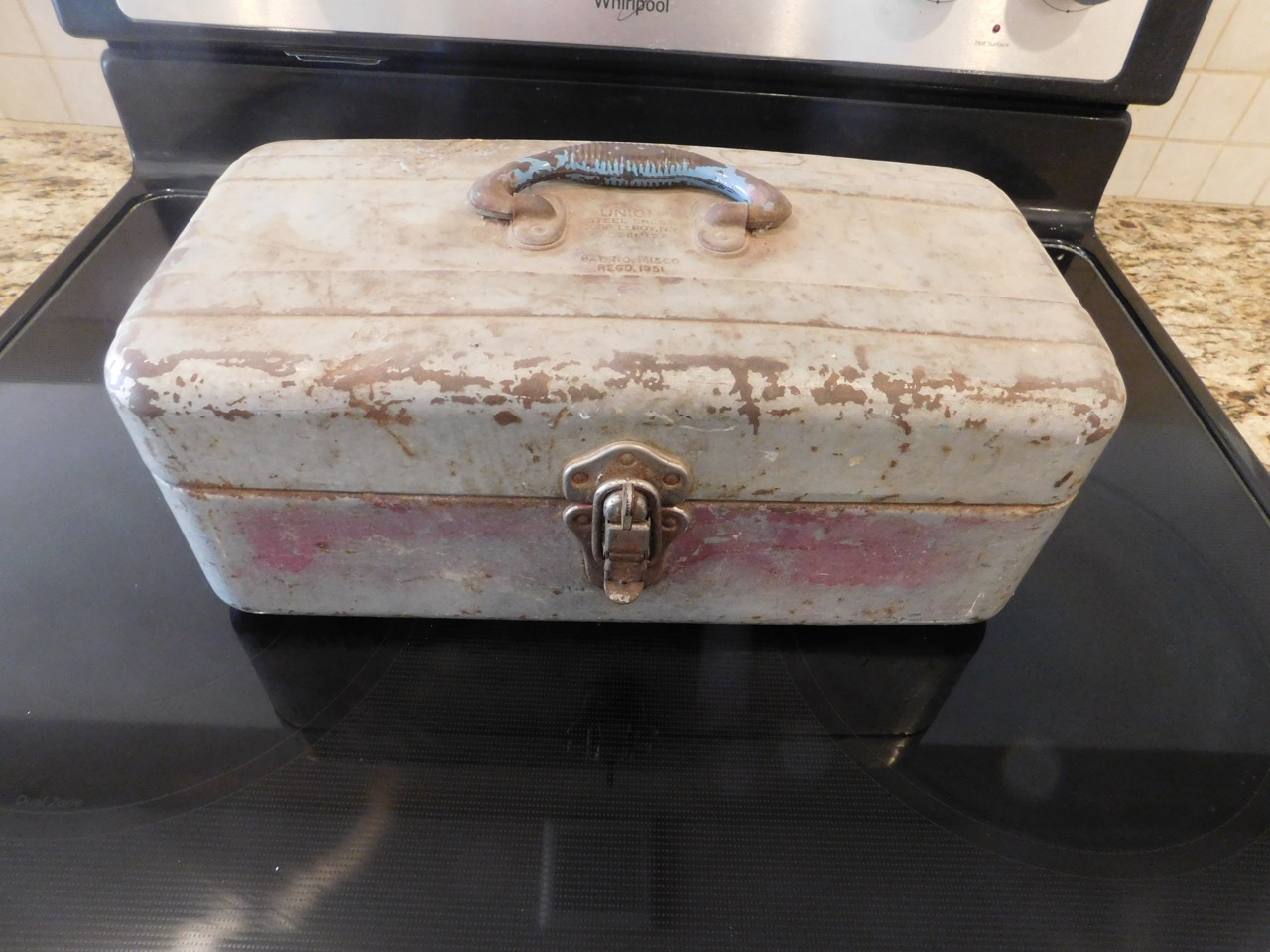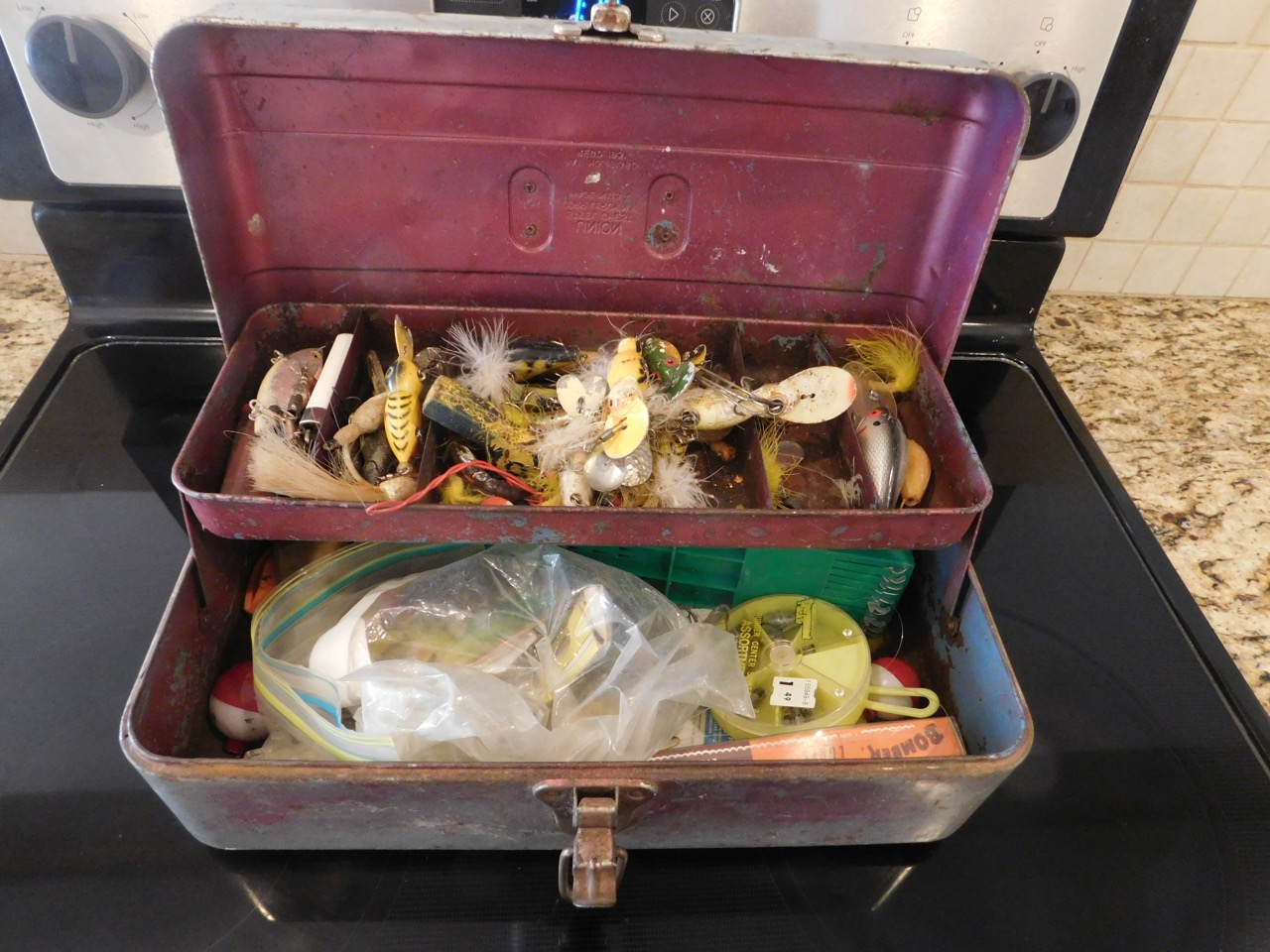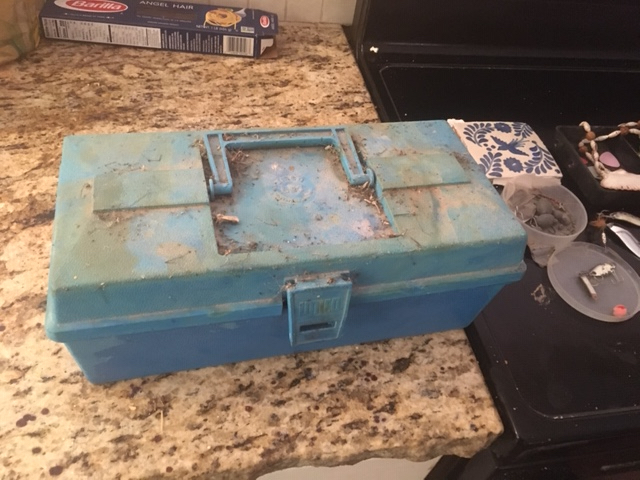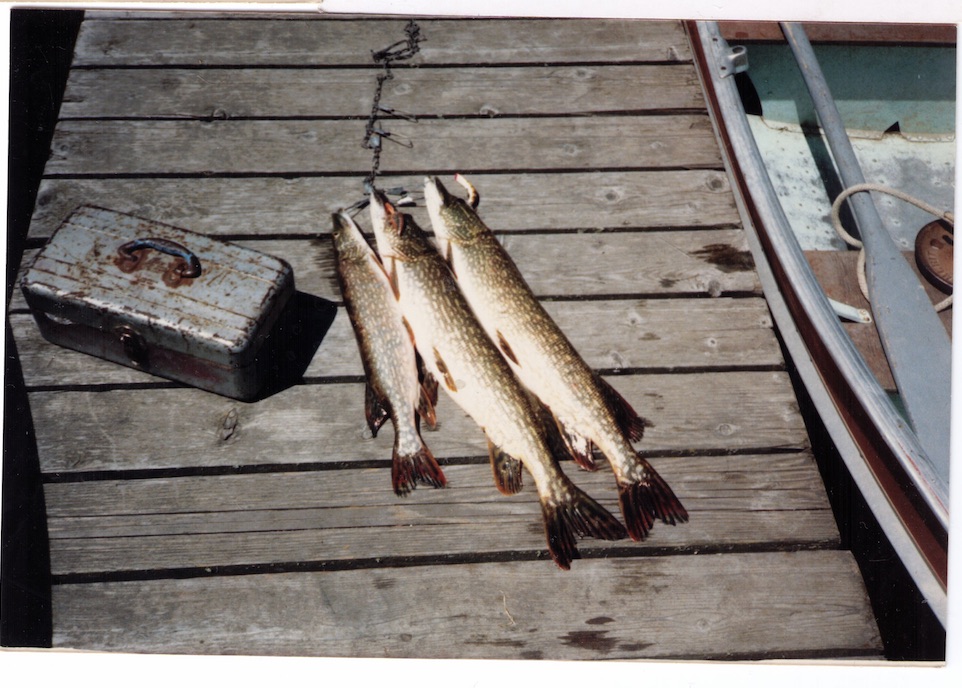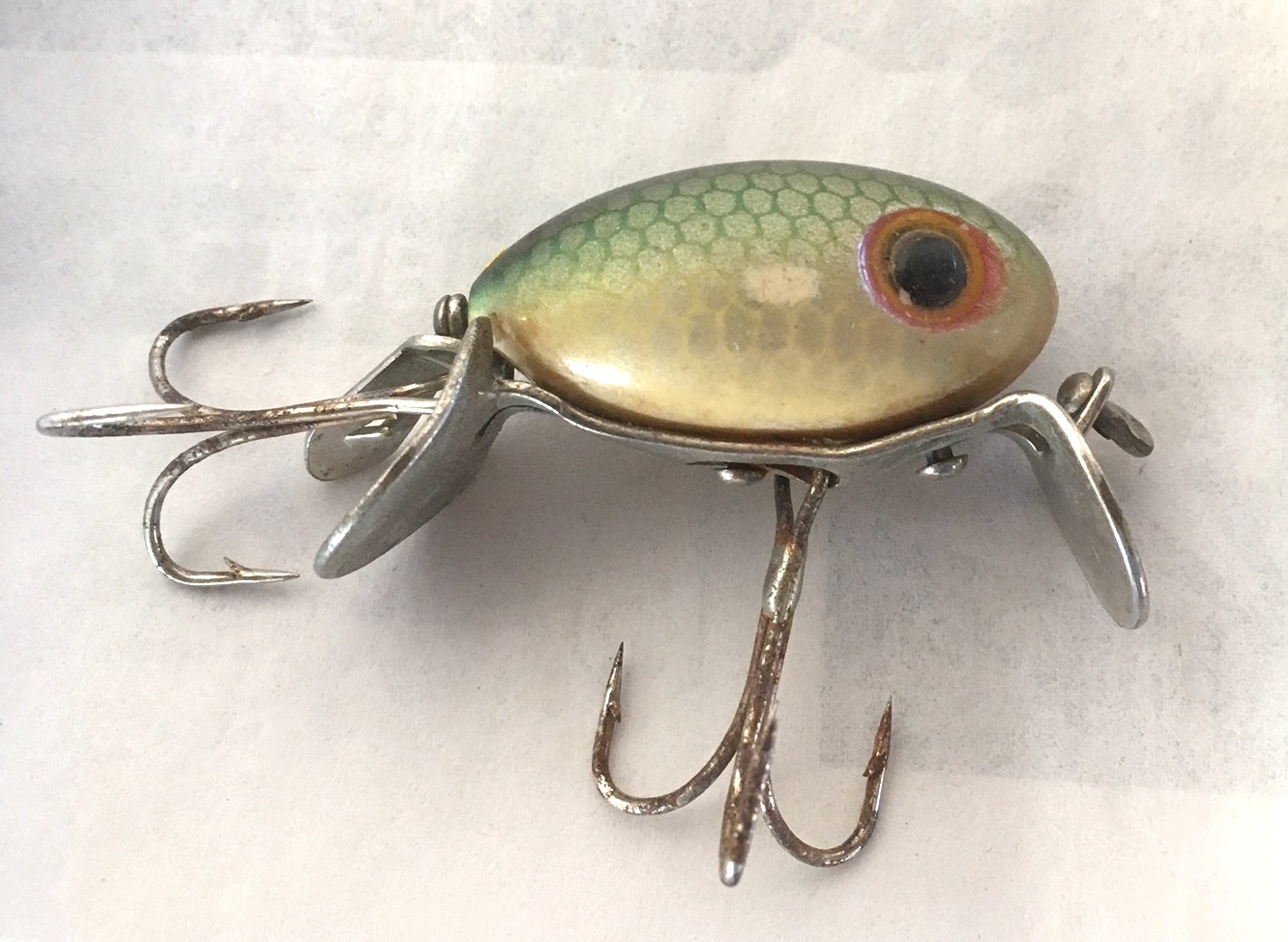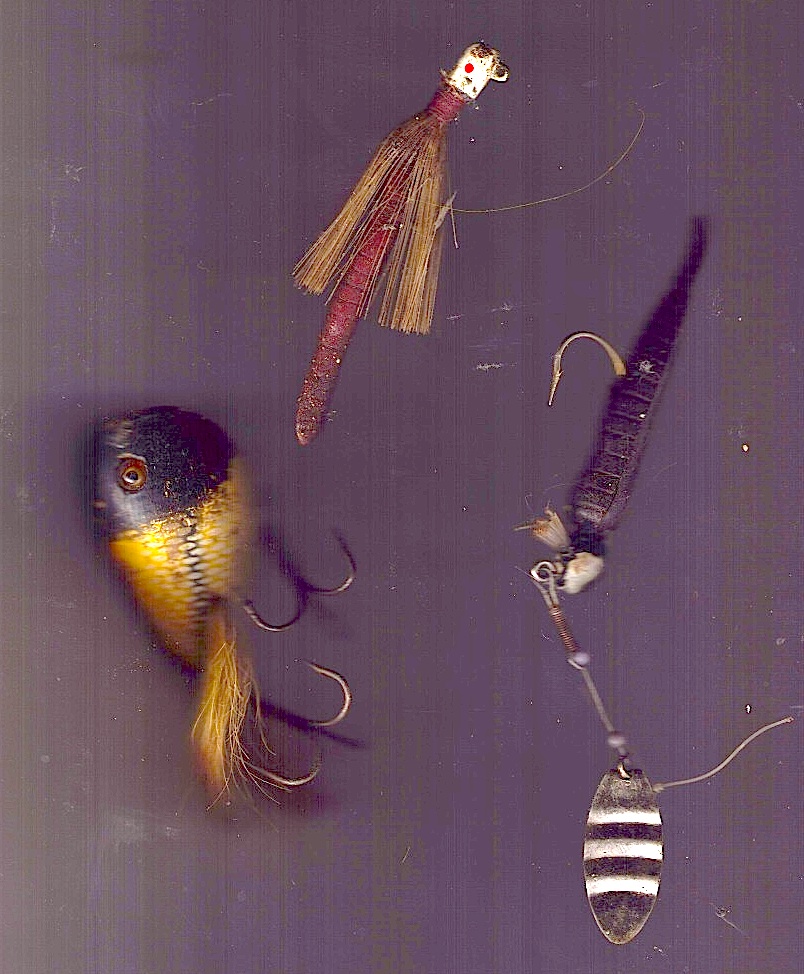
fishinglures.jpg
LEFT: My dingbat that I caught big bass on. MIDDLE:
Jeff's jig that he lost underwater in the crappie
hole and which later I dove down and saw and
recovered. RIGHT: Bill Underhill's super beetle.
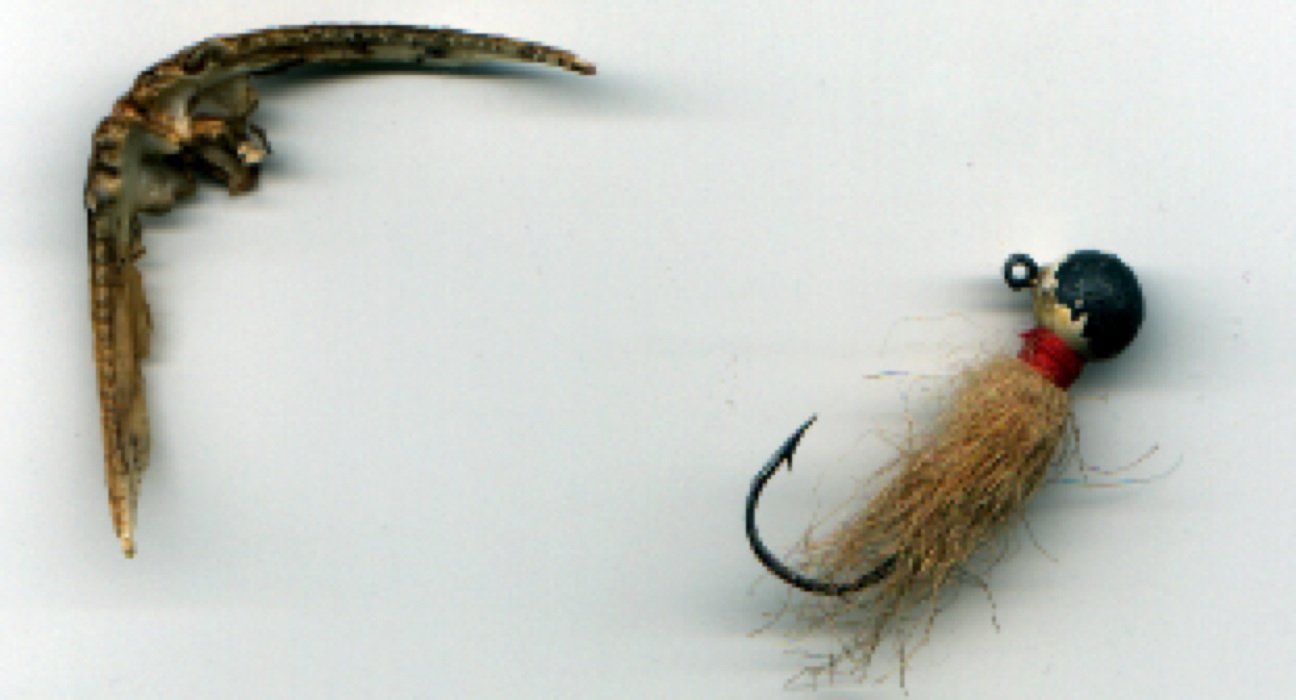
jigfly picture.jpg
The Canadian Jigfly above is the first lure I ever
caught a fish on.
The jaws of that very fish are in the picture too!
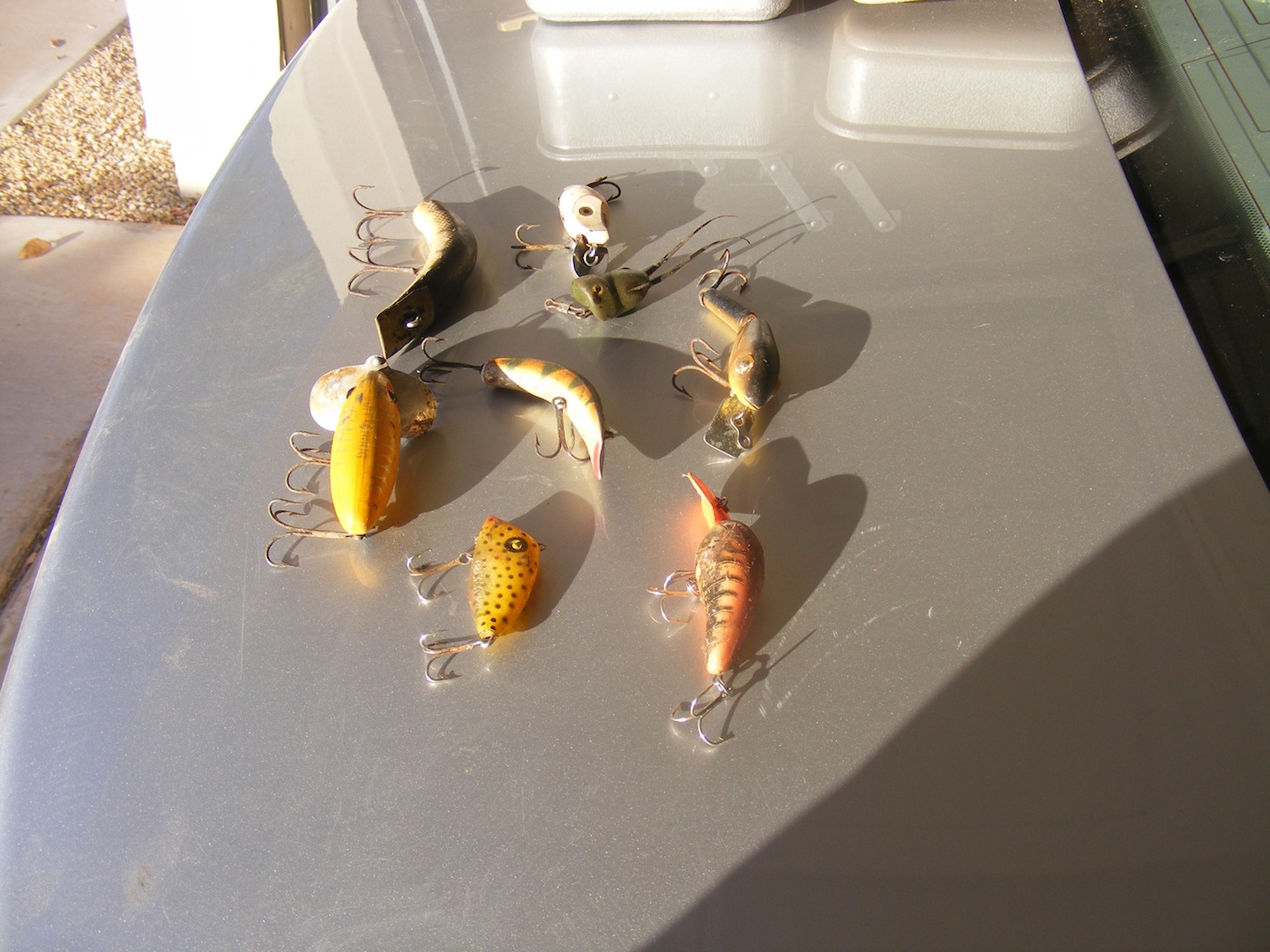
retired fishing lures1.jpg
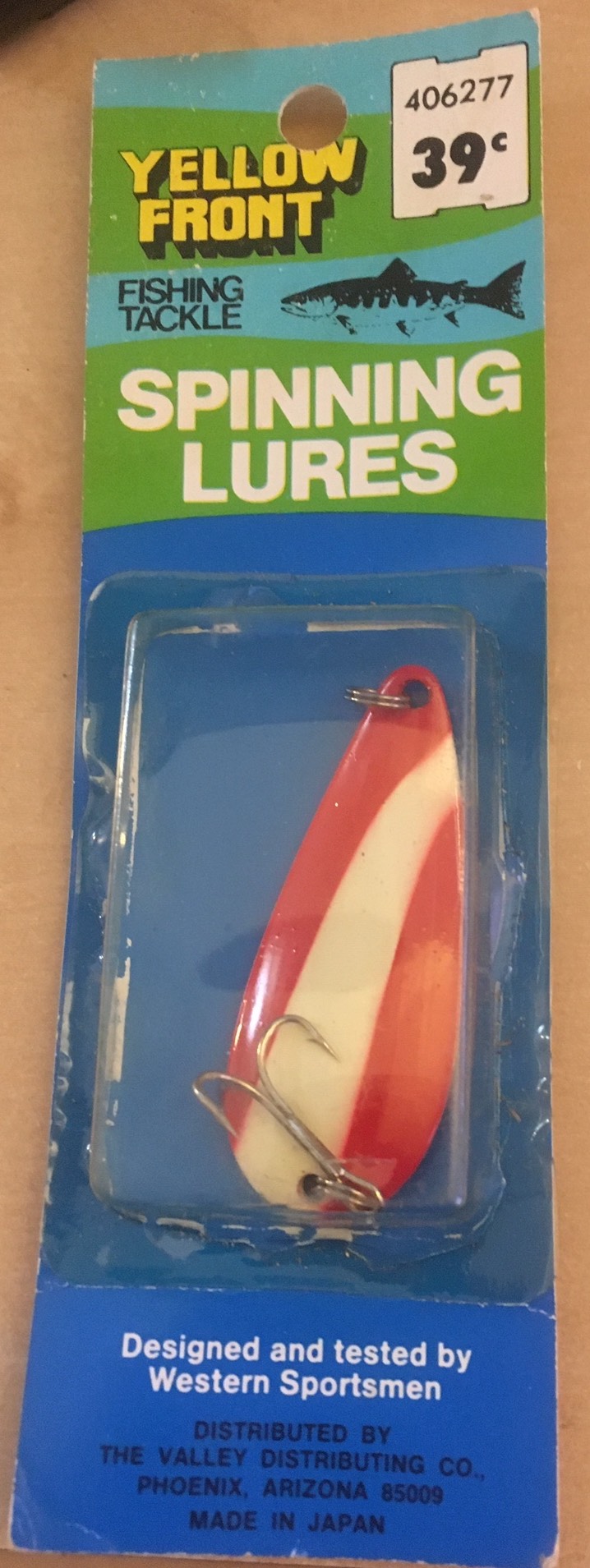 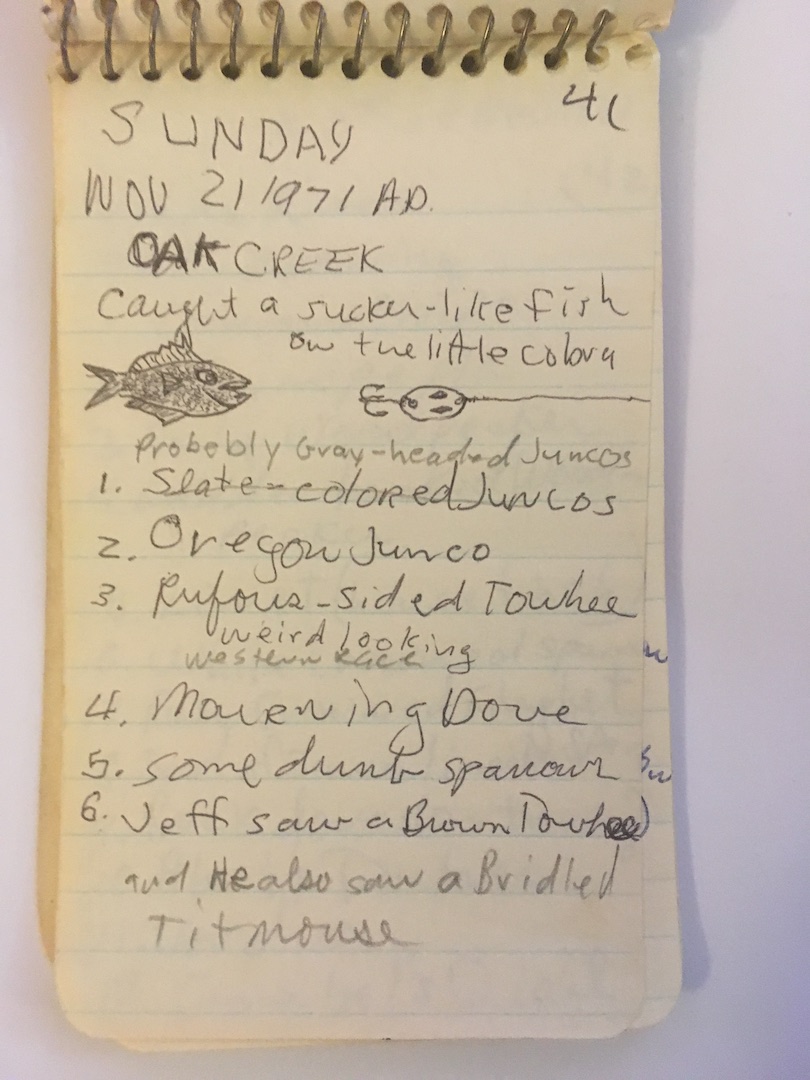
First Bird NotebookIMG_5856.JPG
Yellow Front Red and White Spoon
Fishing Lure Still in Its
Packaging.jpg
Took it home from Mexico in Nov of 2019
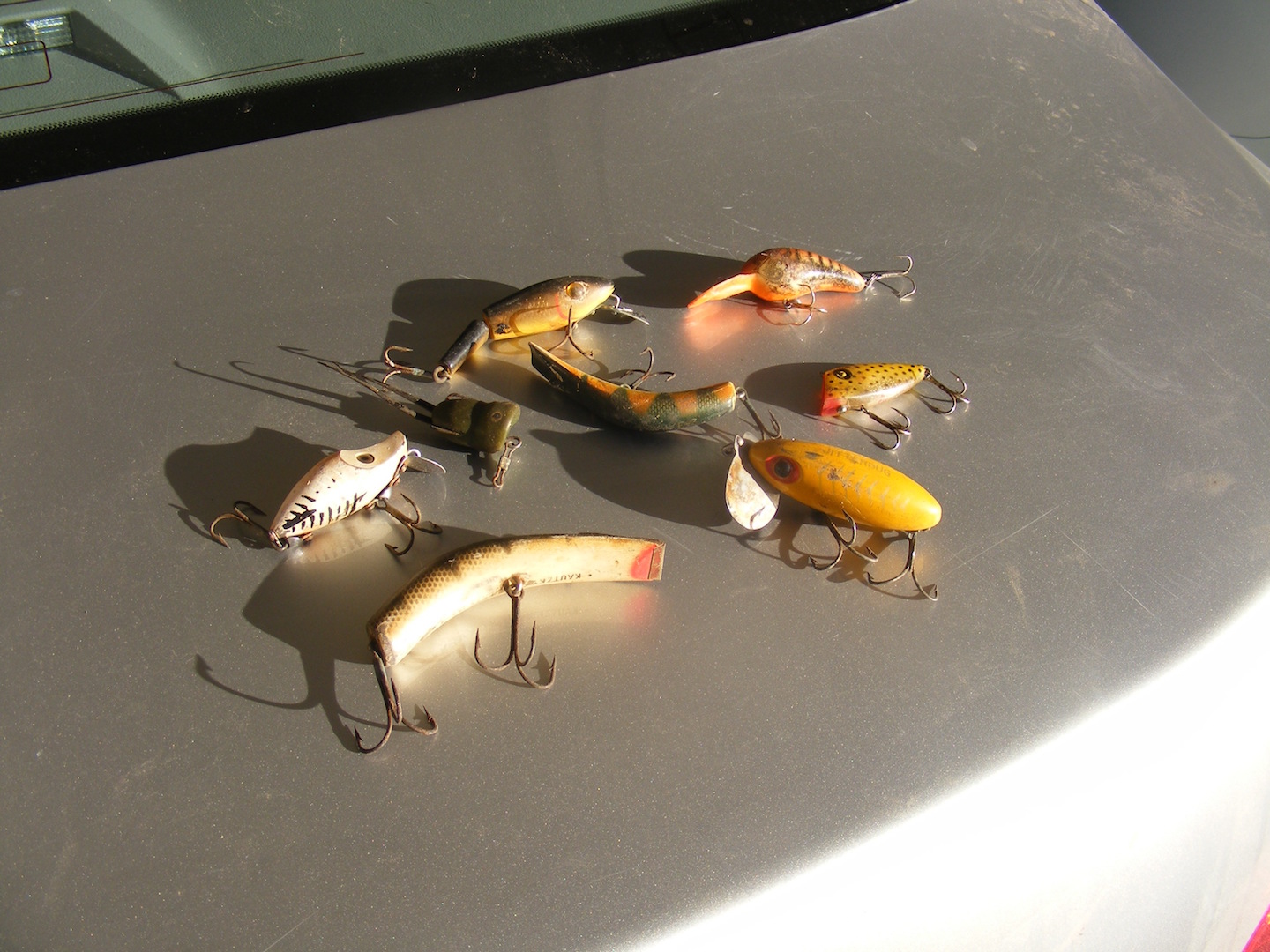
retired fishing lures2.jpg
MIDDLE:
Perch-colored Lazy Ike, a walleye killer!
RIGHT AND BELOW THE LAZY IKE:
Steve's Yellow Jitterbug. Destroyer of
bass!
TOP RIGHT:
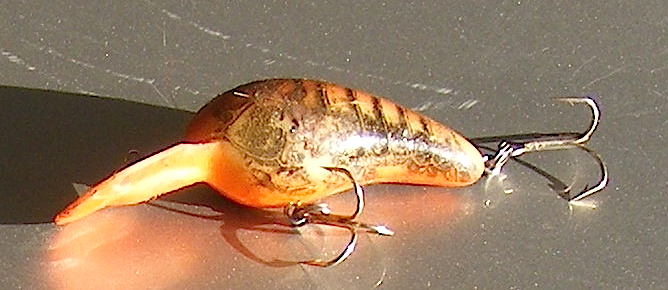
The Deep-divin' Jesus, the lure Steve
tricked a Jesus freak into giving him
free. We caught these
fish with it.
SMALL GREEN RUBBER POPPER:
Steve's popper from first trip to Itasca.
OTHER LURES: jointed Mirror
Lure, White Creek Chub Lure, spotted super
sonic-like lure. Bottom left: large-sized
Lazy Ike.
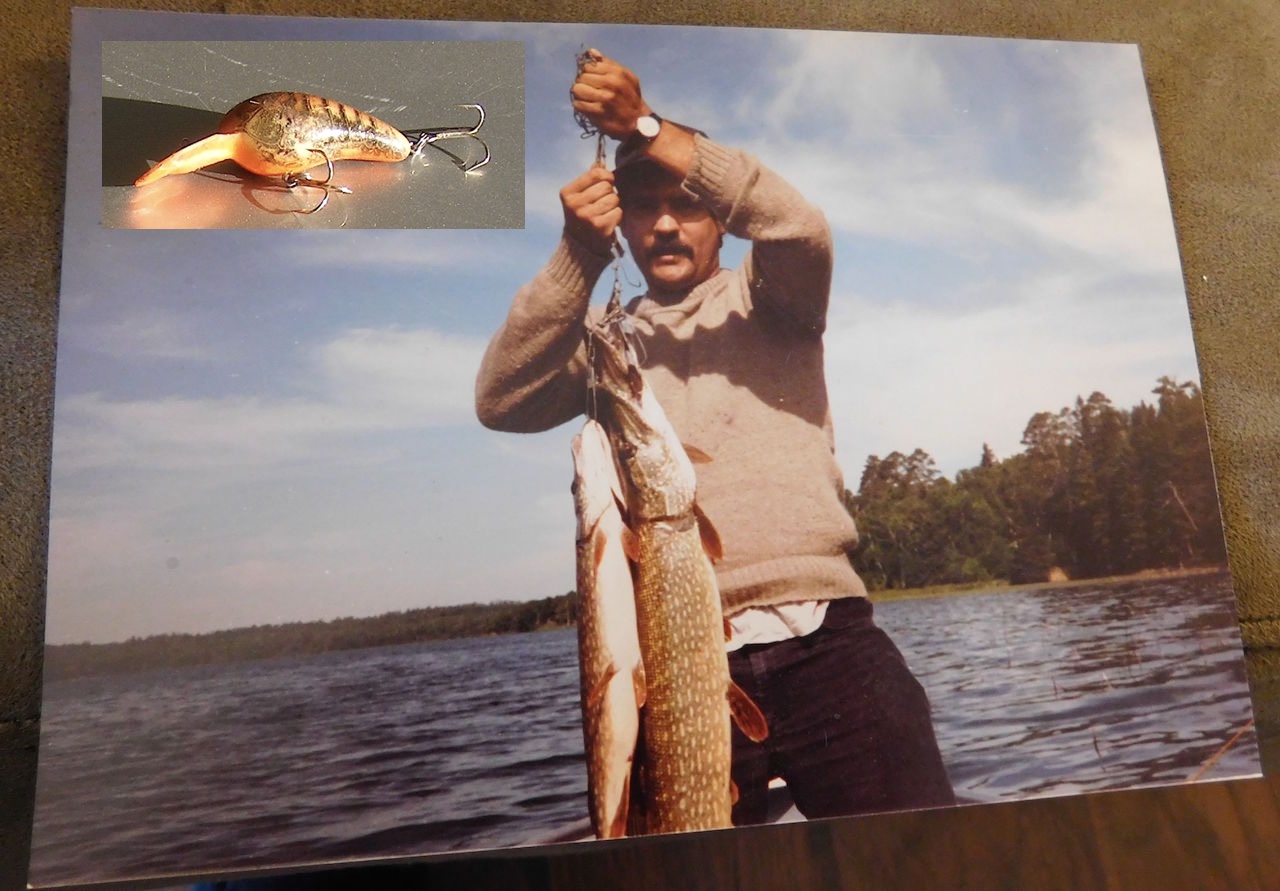
Tom, Pike, Itasca 1987, Deep Diving
Jesus.png
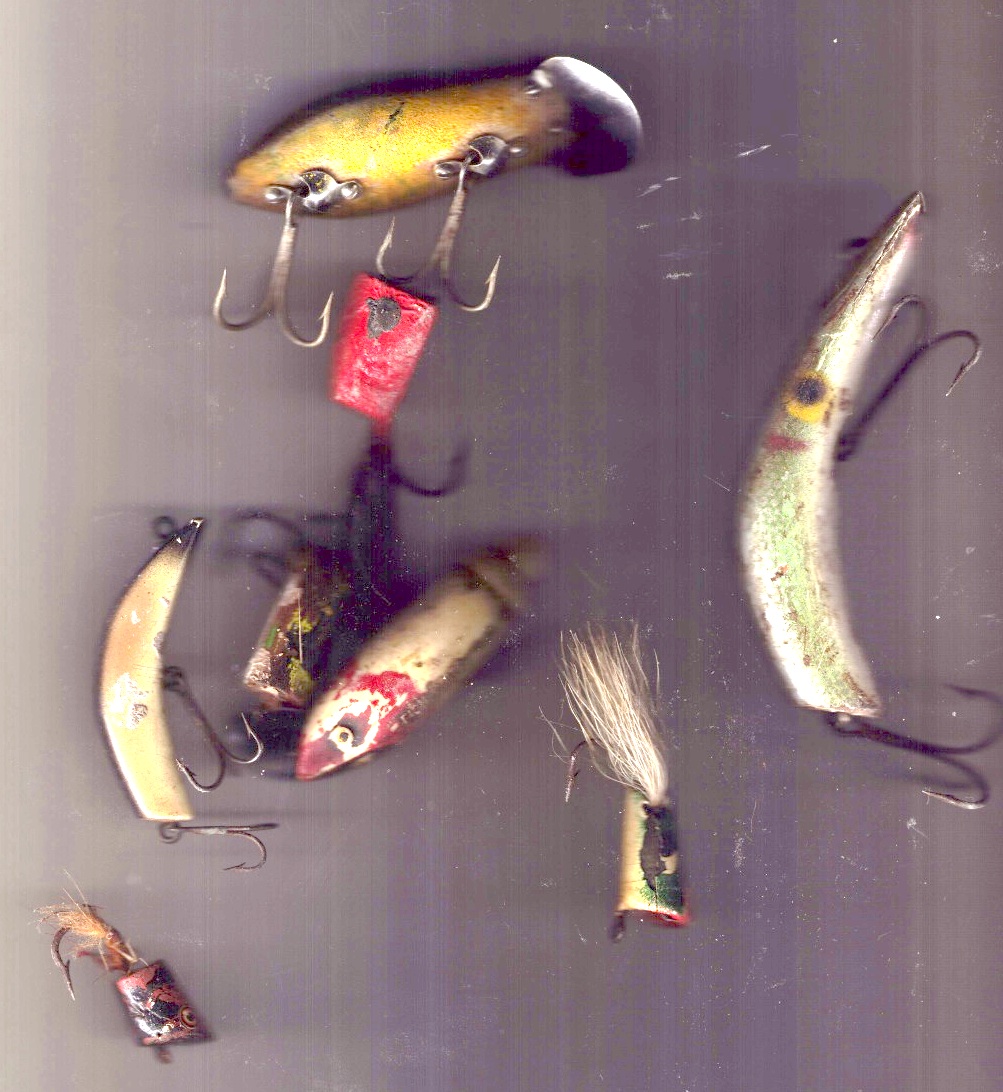
fishinglures2.jpg
TOP:
My Meadow Mouse, which I never
caught a fish on and whose tail
is missing.
LEFT MIDDLE: The lazy ike-like
lure that Bill Underhill gave
me. It is a rattler.
Assorted poppers that are spread
about; some are obviously
homemade.
MIDDLE: Red-headed Basareeno.
It's the ORIGINAL folks.
RIGHT: Giant sized Lazy Ike. I
remember losing a bass on it out
by the bog across the lake near
Schoolcraft Island.
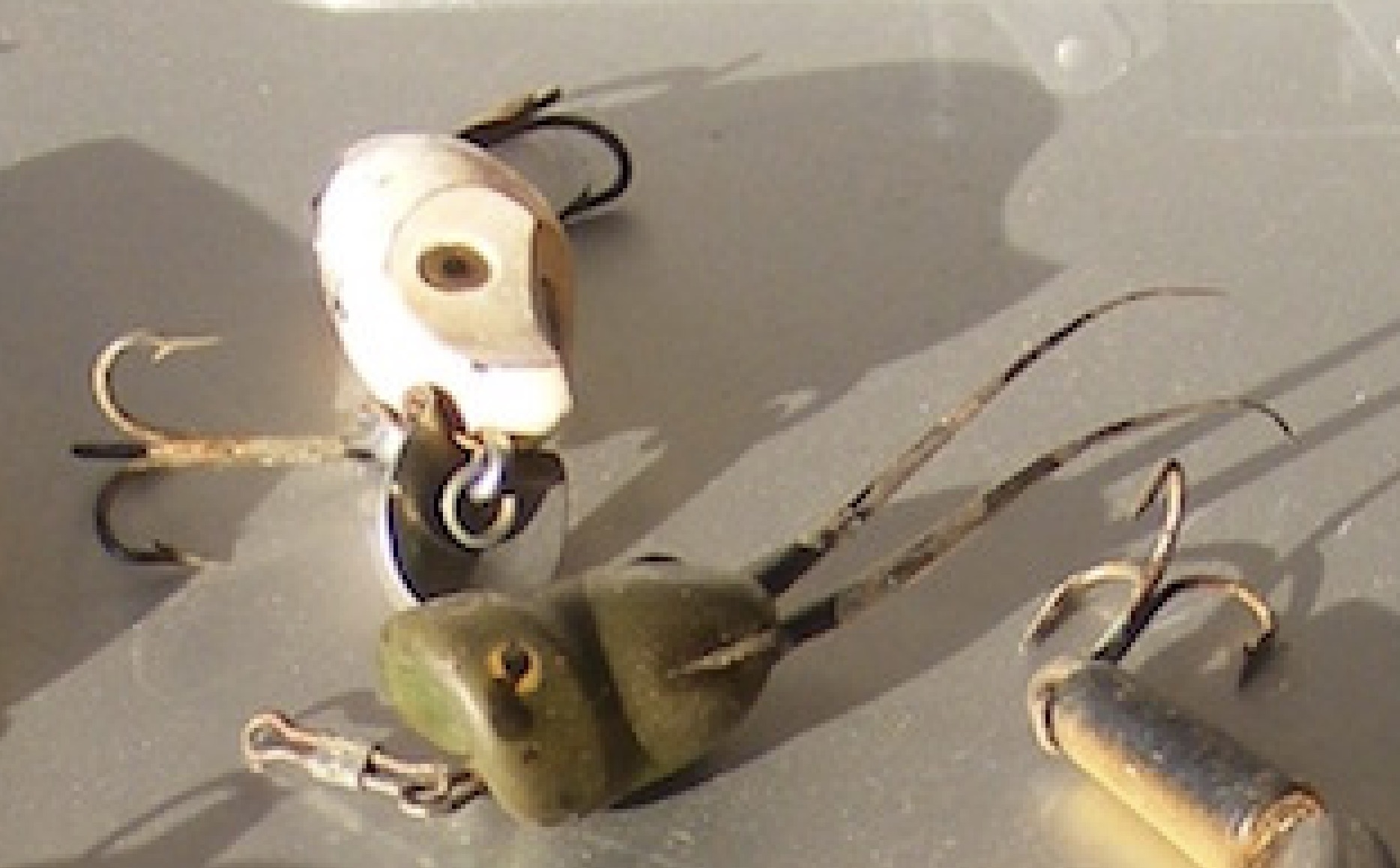 Popping Bug
Close-up.jpg

Sonny with Bass he caught on my jitterbug Douglas
Lodge Itasca year 2000.jpg
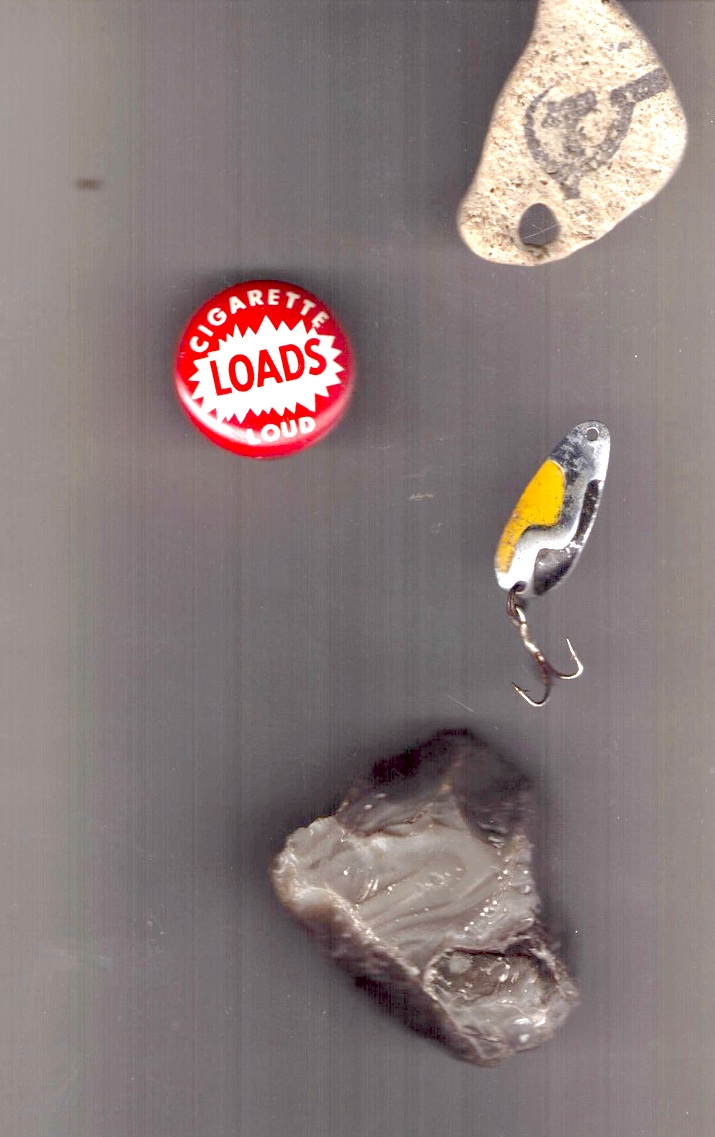
caliopespoonjeff.jpg
And Jeff's jasper-like rock from the East Verde?
It's Jeff's anyhow.
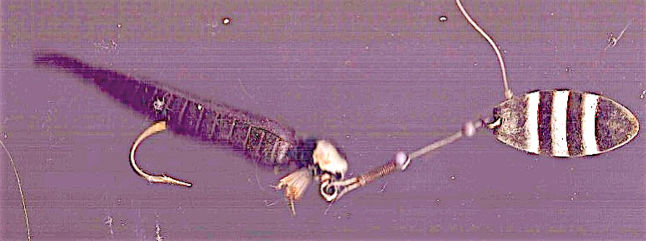
Bill Underhill's Super Beetle.png
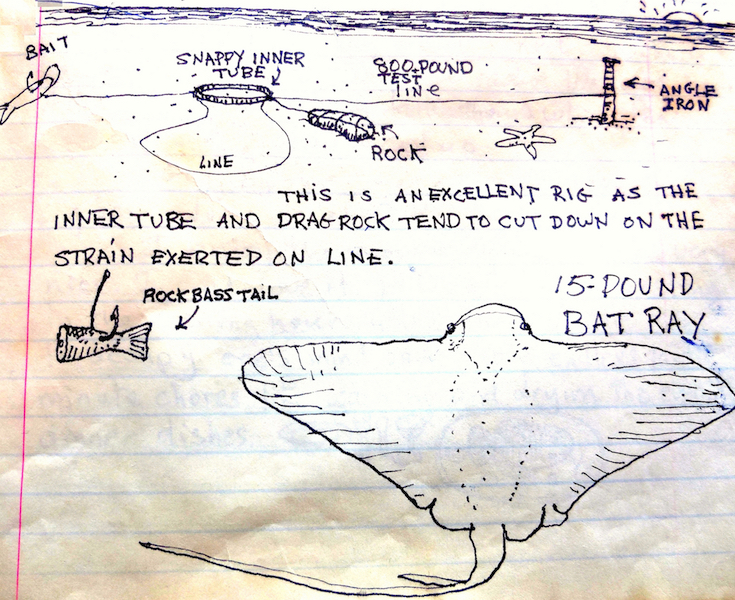
bat ray rig Enderezado y HQ Recortado.jpg
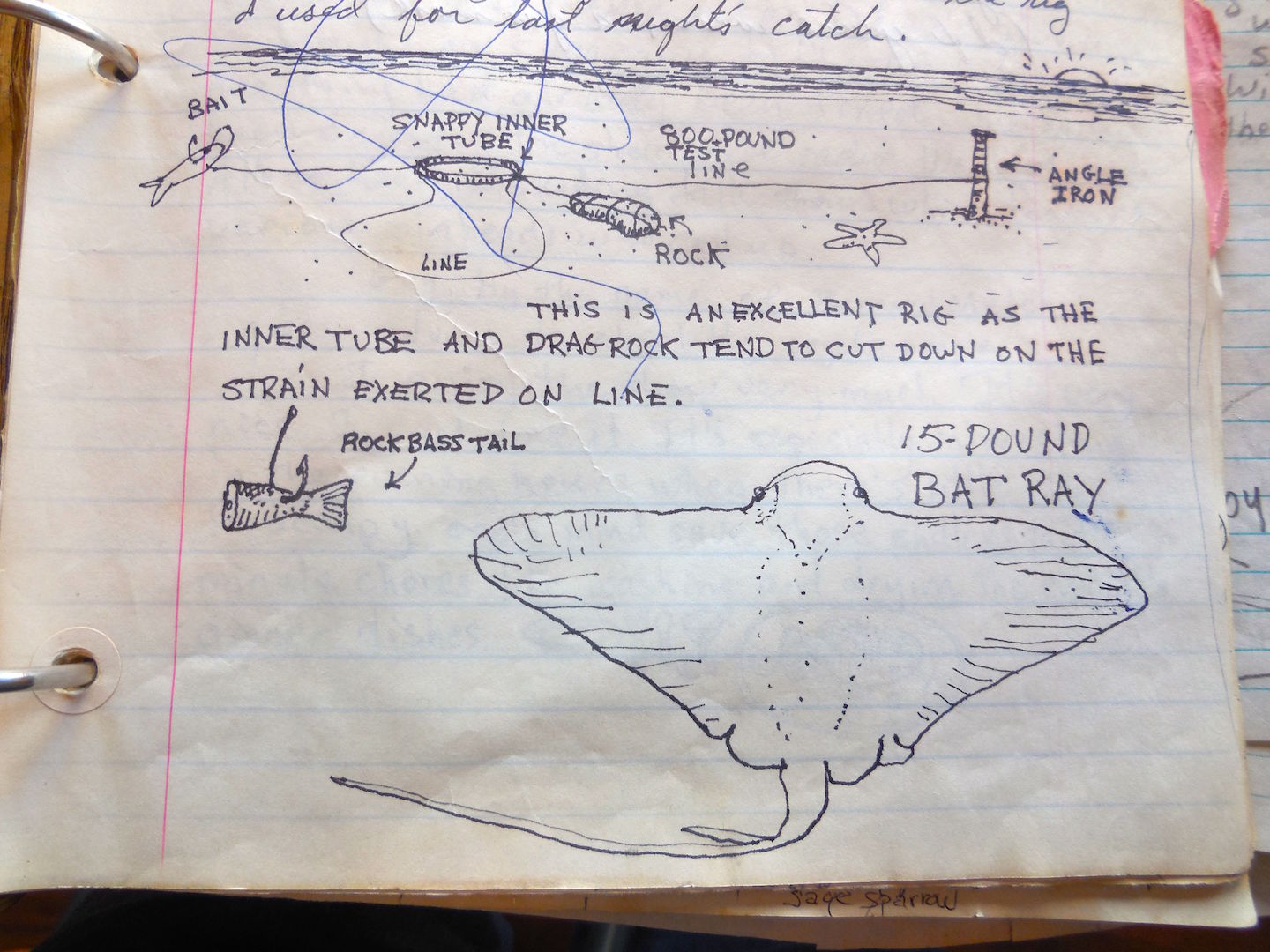
Bat Ray Rig.jpg

Kastmaster castmaster.jpg
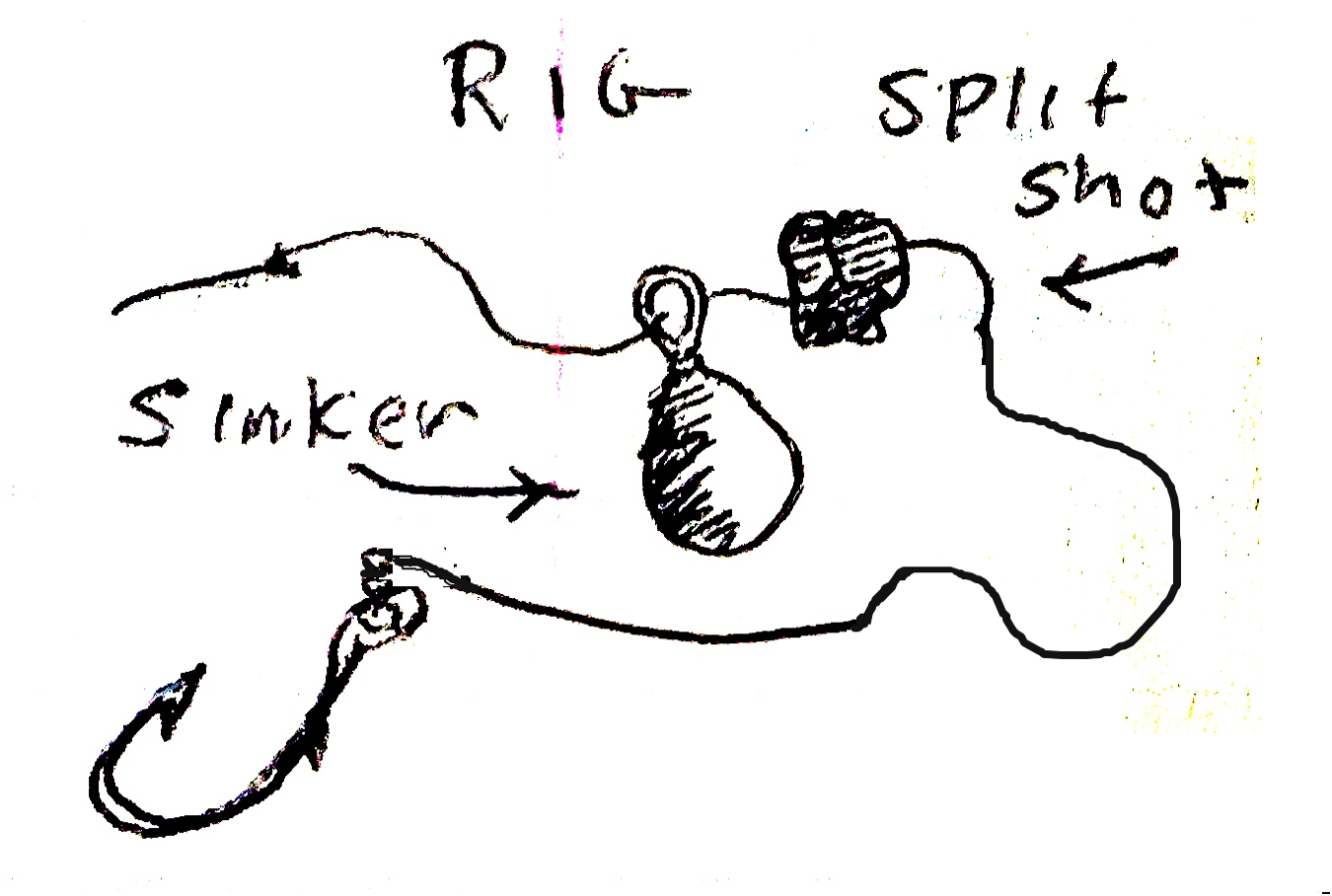
sinker rig redone.png
STEVE'S FISHING KNIFE BELOW

fishing knife1.jpg
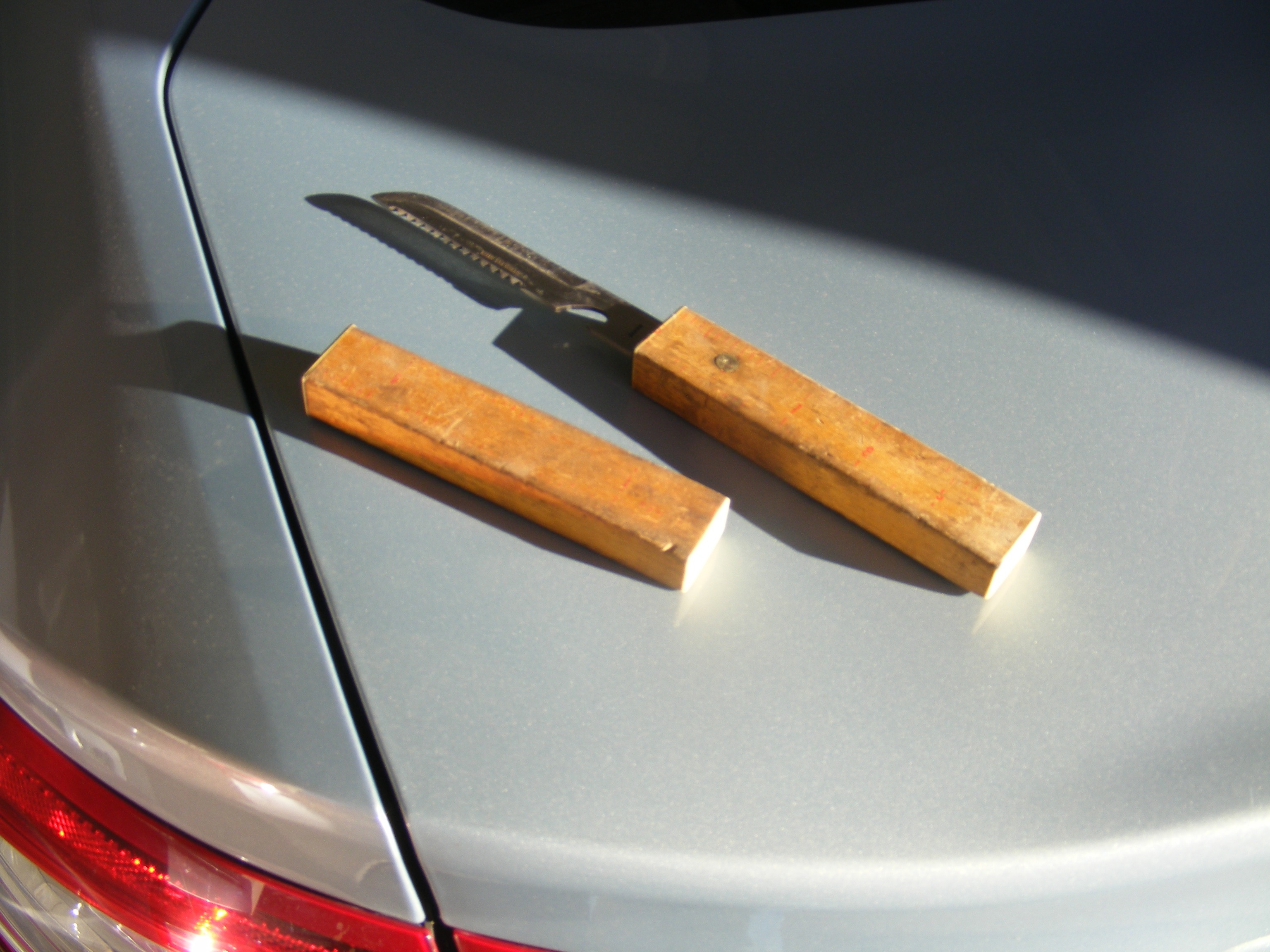
fishing knife2.jpg
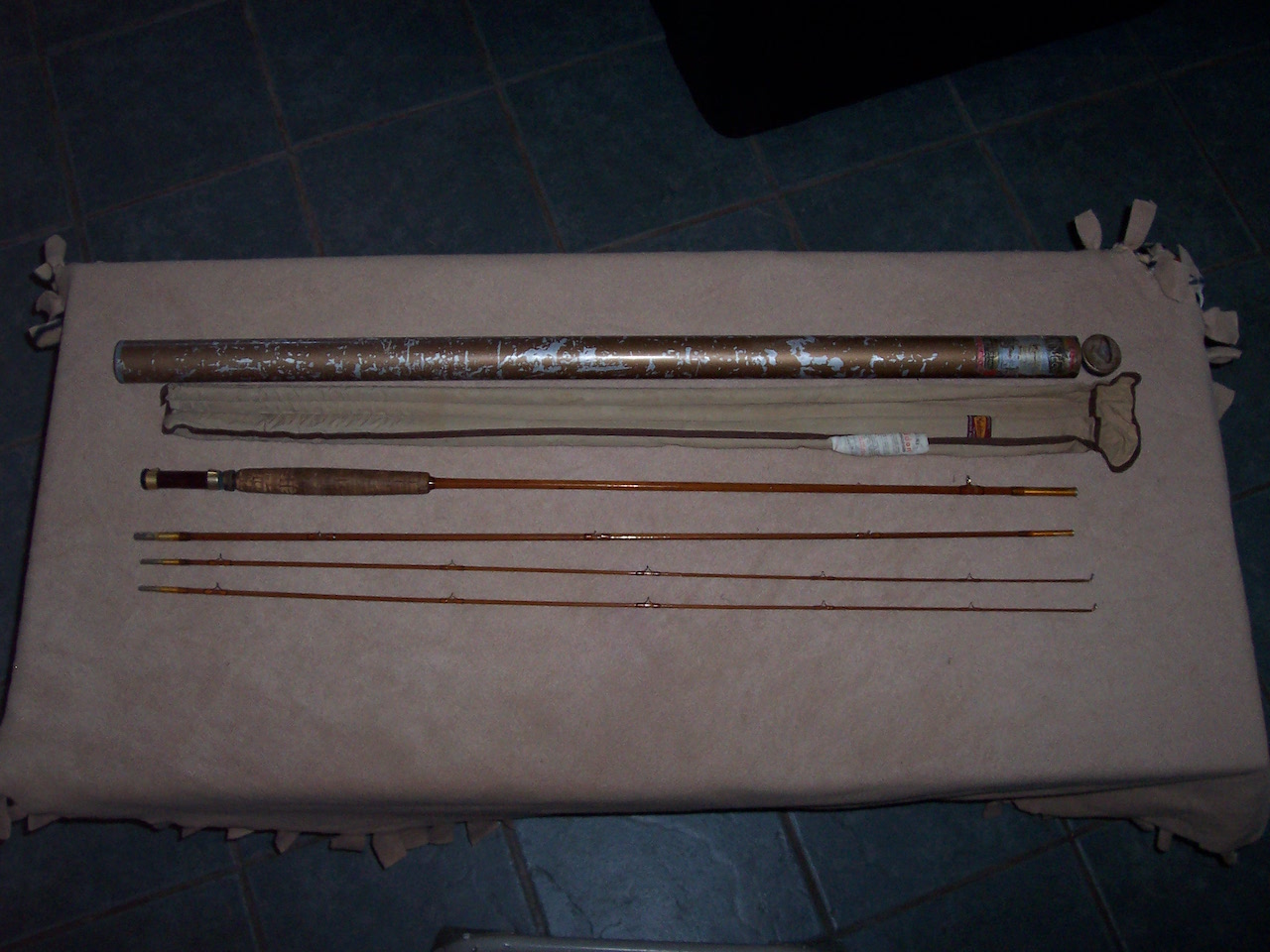
Tom Hascall's fly Rod A.JPG
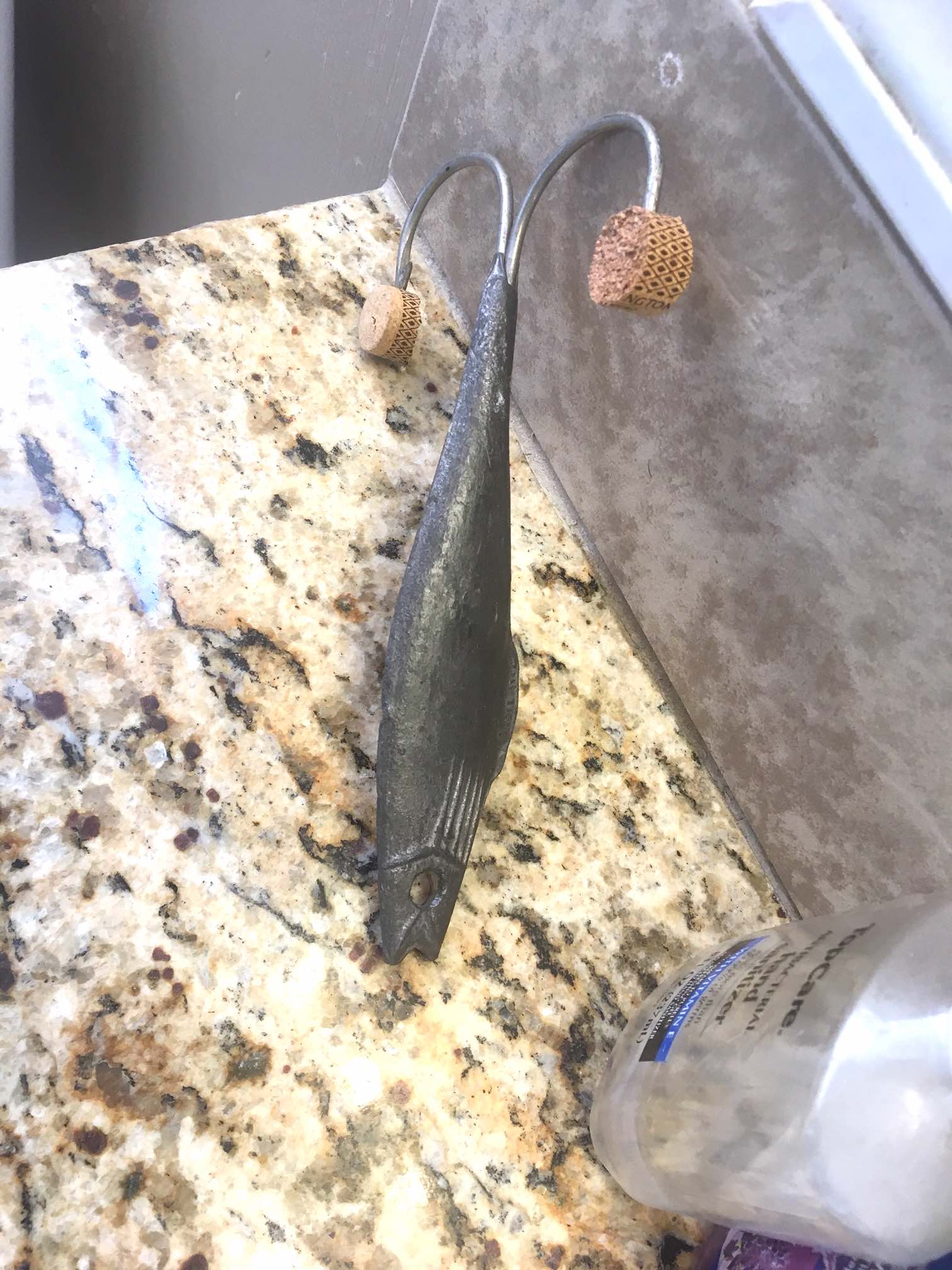
Here's a Lure I almost got hooked on so when Jeff
came I borrowed his wine cork to make it safer.
It's big; you could catch ME with it EASY.
Fishing Lure with Wine Cork.jpg
ALSO HOME NOVEMBER 2019:
TACKLE BOX CONTENTS
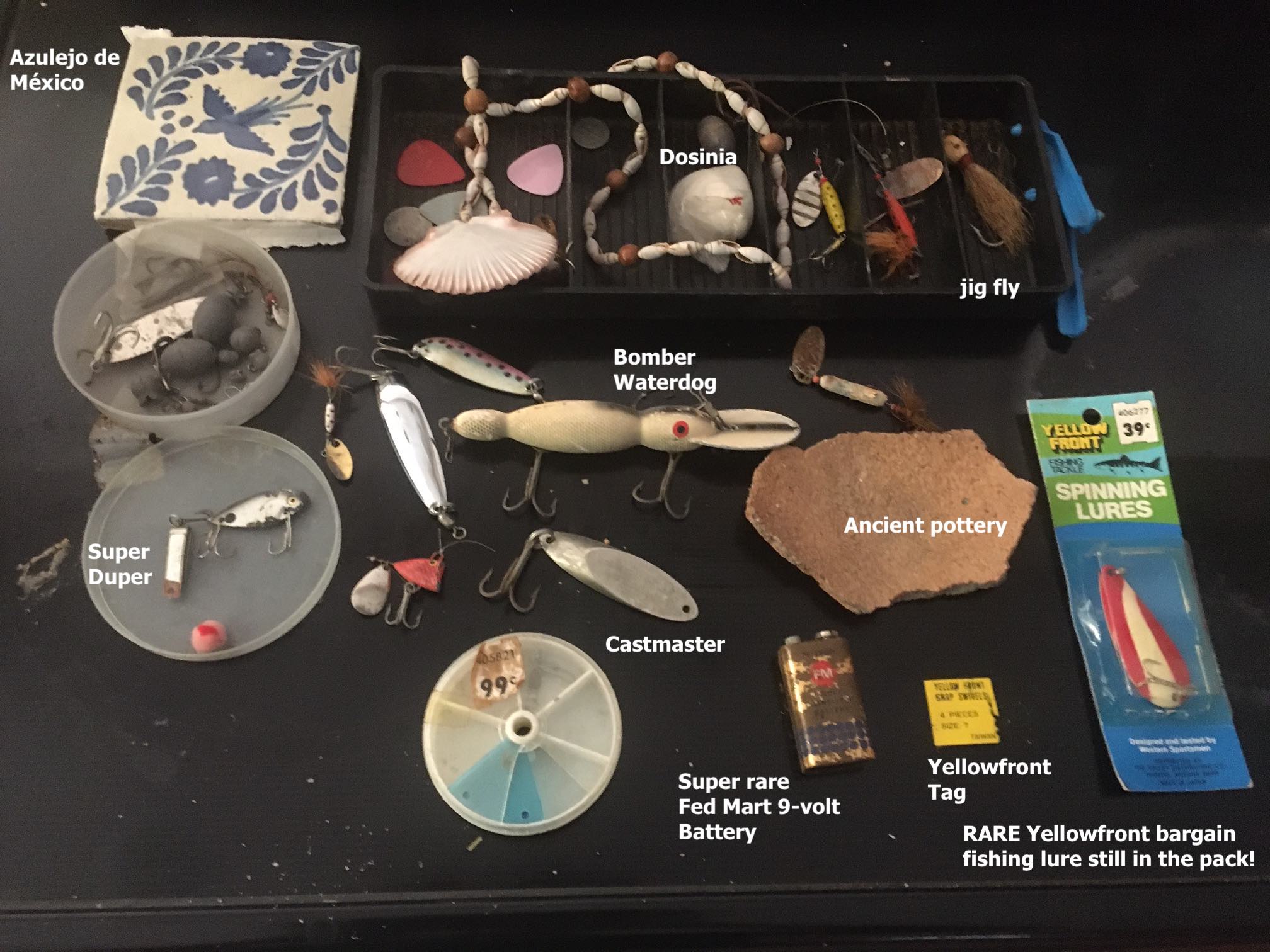
Mexican Tackle Box Contents.jpg
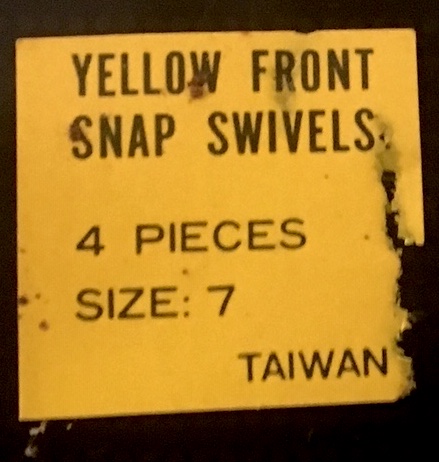
Yellowfront Tag.jpg
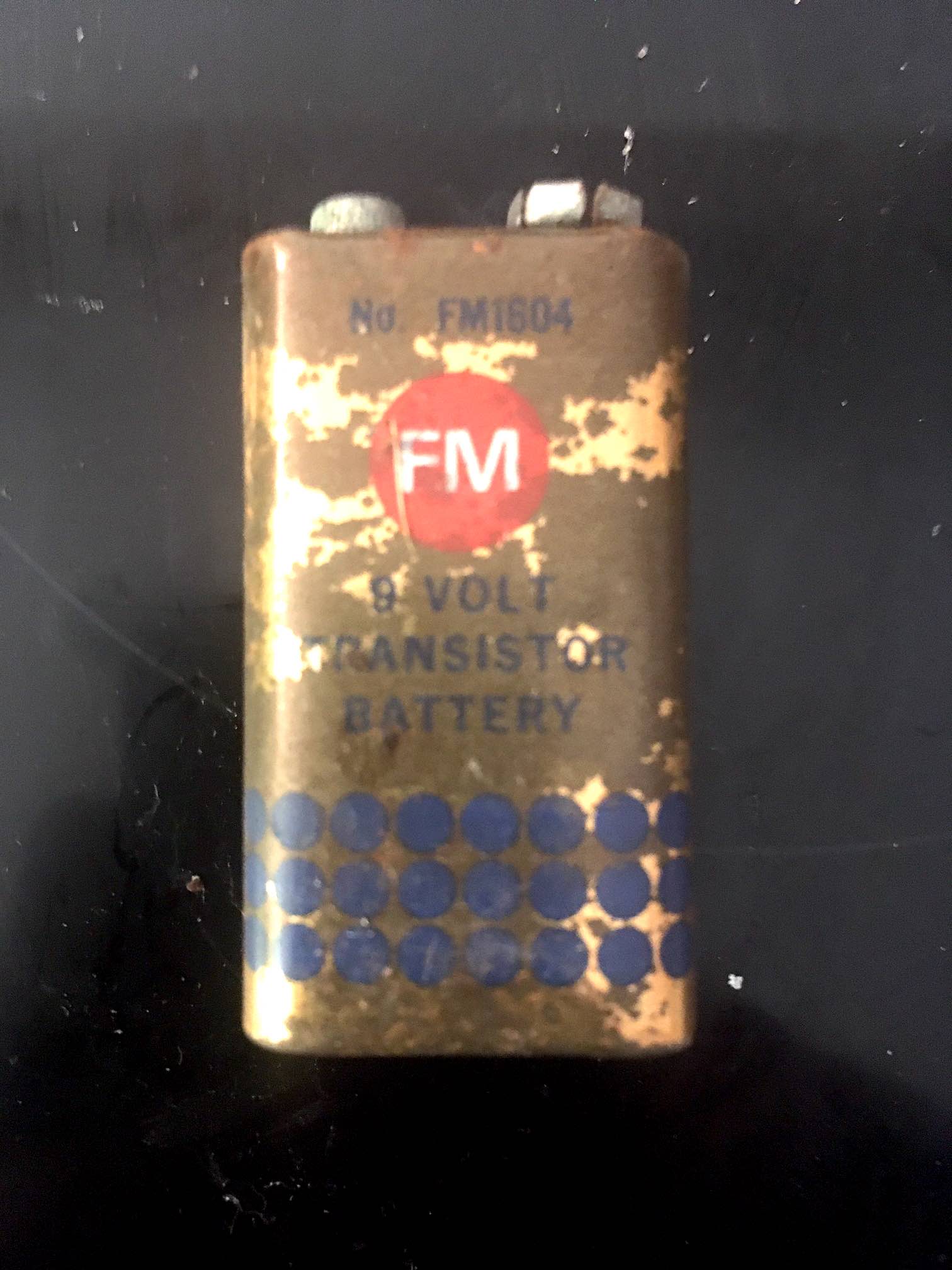
Fed Mart 9-volt Battery very rare.jpg
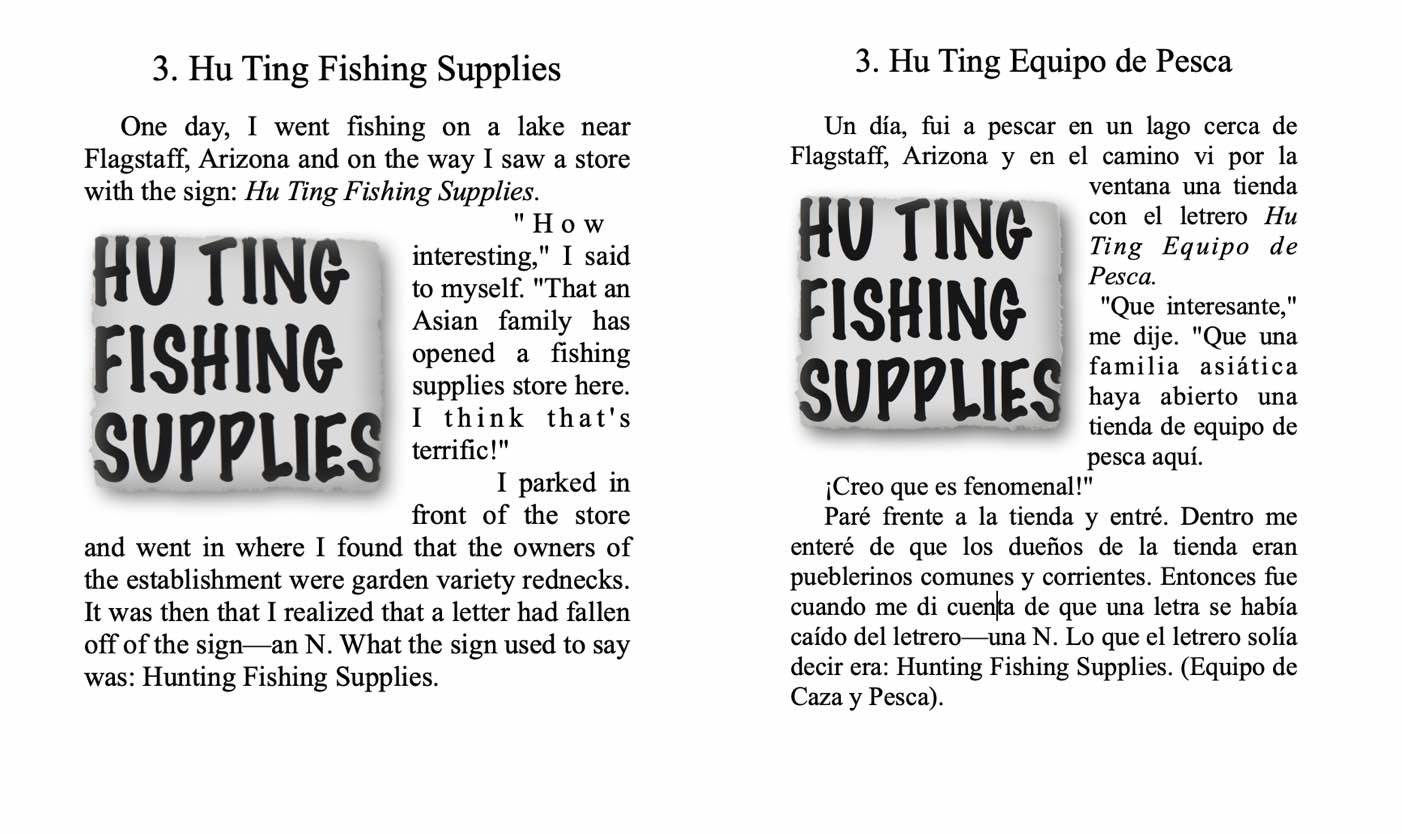
Hu Ting Fishing Supplies.jpg
From my Book Gone Are the Days
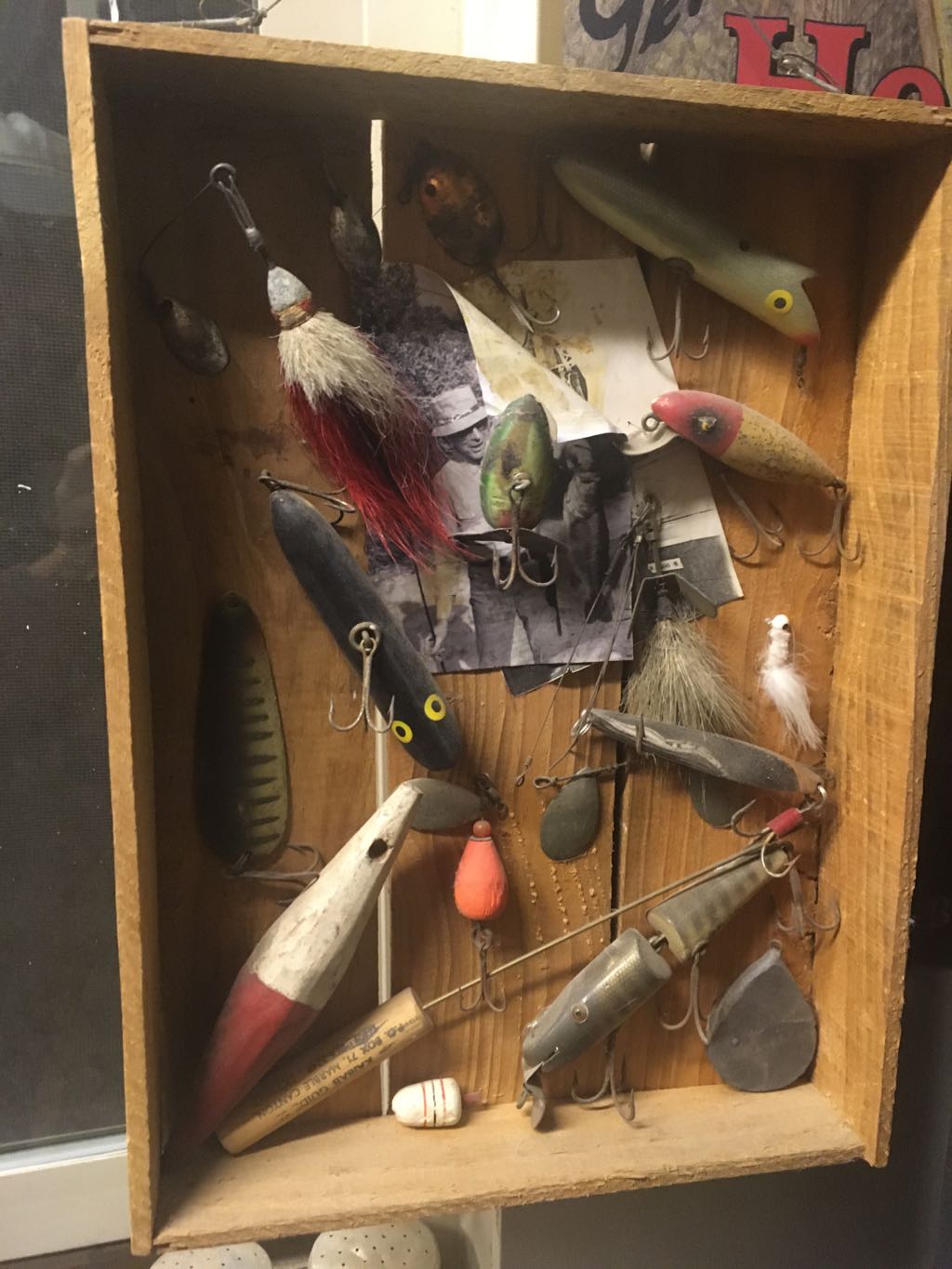
fishing lures at Dits house feb 21, 2022.jpg
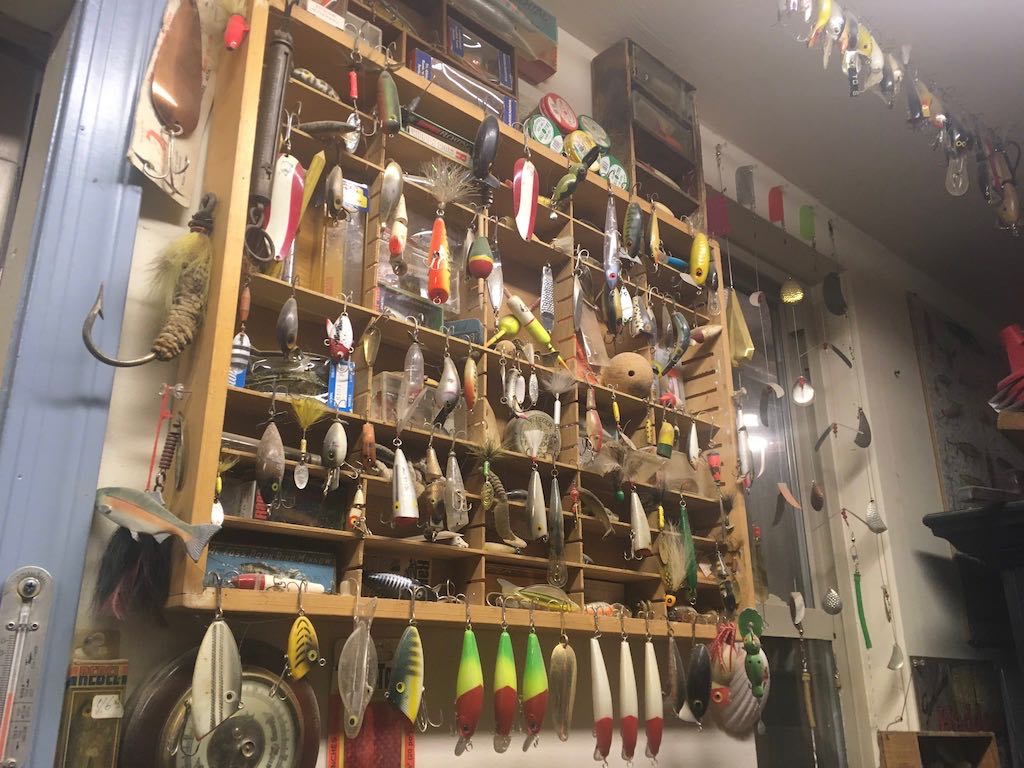
usery mountain pass feb 21, 2022d.jpg
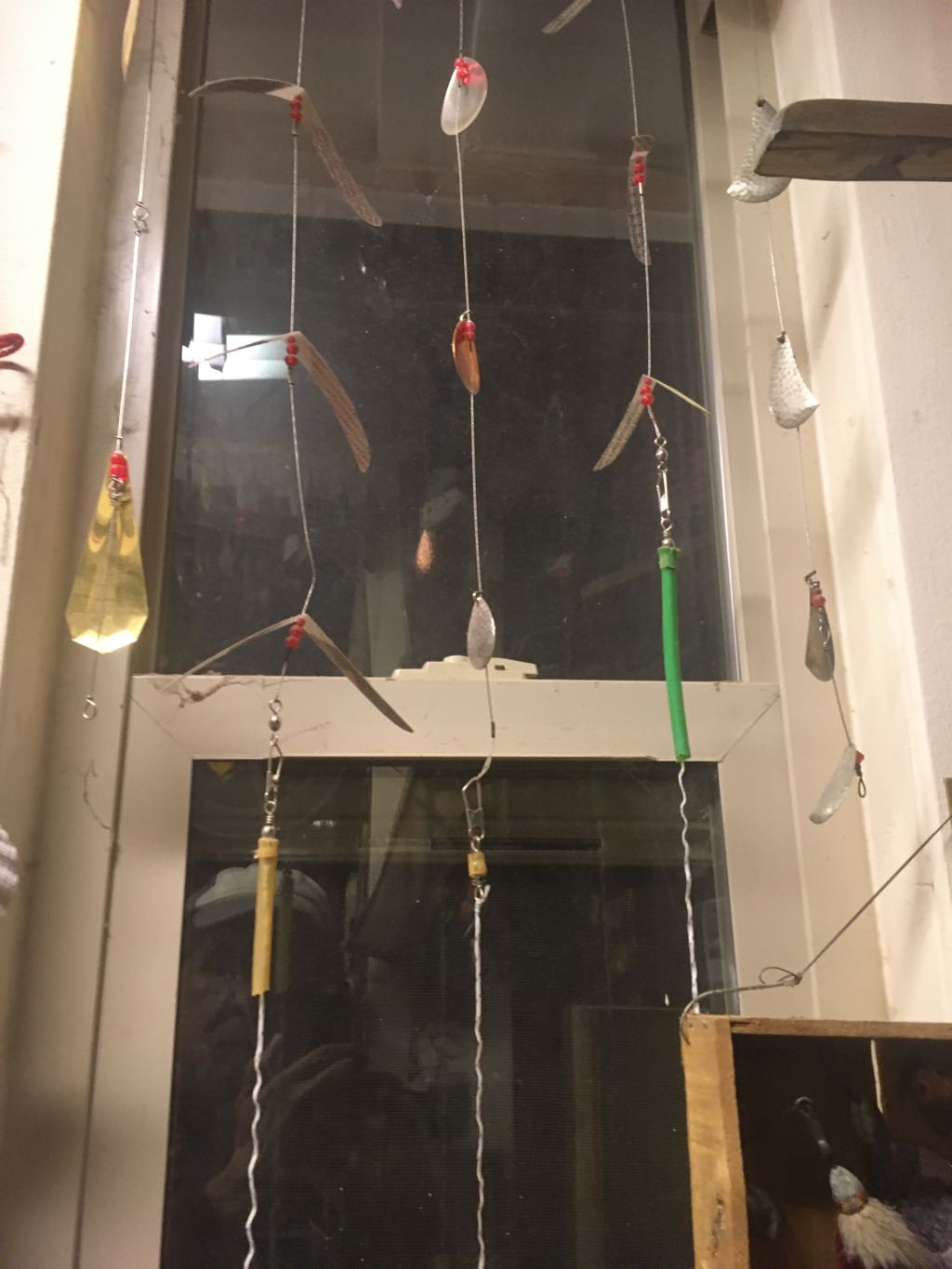
usery mountain pass feb 21, 2022b.jpg
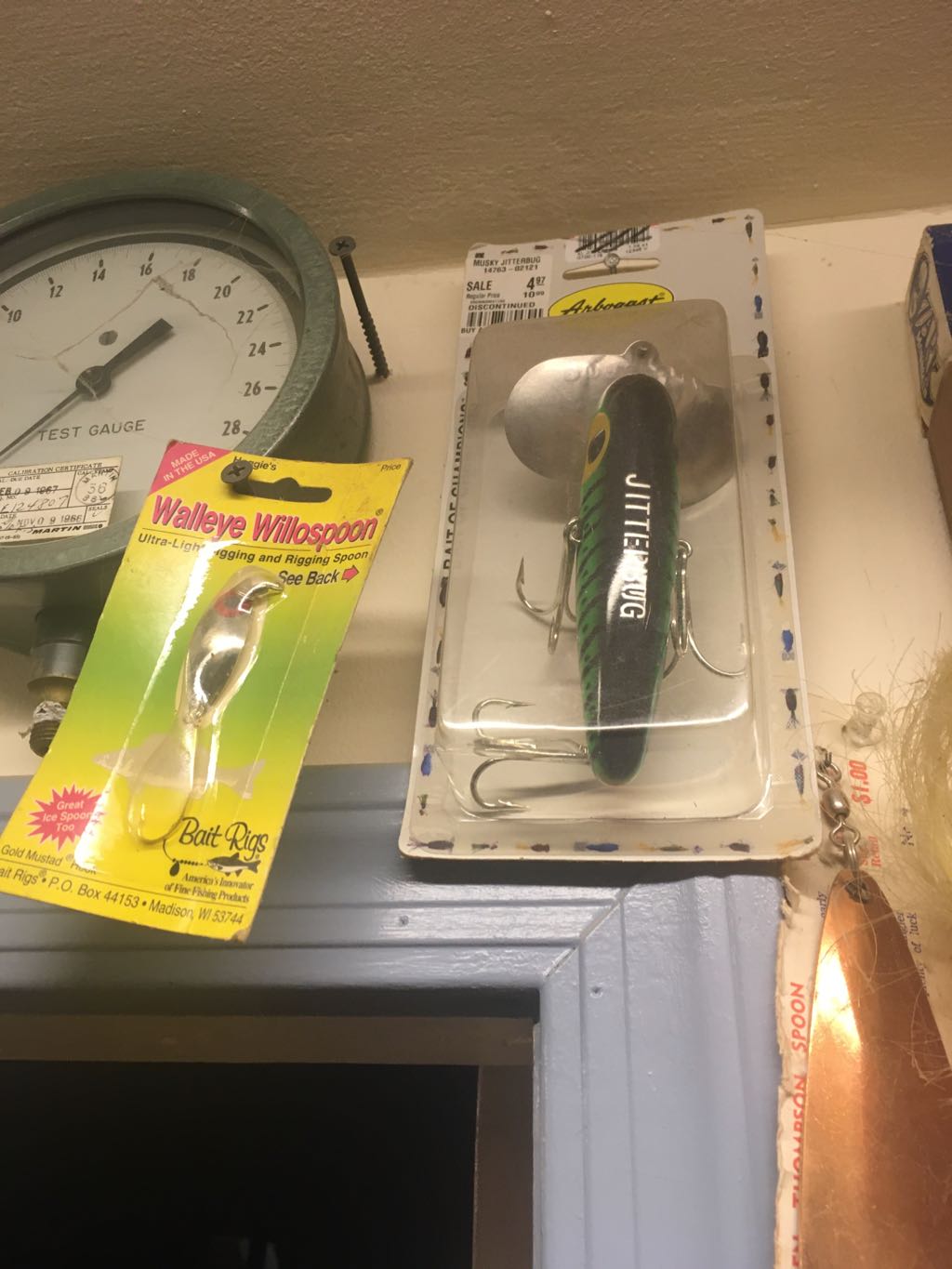
fishing lures at Dits house feb 21, 2022cc.jpg
Stephen Cole
The
Castmasters
It was
in June 1963 that my father somehow got
his hands on an old Mexican panga equipped
with a 25-horse Evinrude outboard and took
my brother and me fishing near the Moruan
Estuary on Mexico’s Sea of Cortez. I
was twelve years old. We’d fished plently
from the shore but we were about to
discover that a boat makes a hell of a
difference.
Before our fishing trip, my father
gave us a little lecture about the
boat. He told us what trim ship meant
and baited us into using unnautical terms in
order that he might humiliate us.
First he tricked Tom into referring to the
stern as the back of the boat and gleefully
admonished him. “Stern!” he hollered,
feigning disbelief.
“Stern,” Tom repeated, ashamed.
Next, he led me toward the bow and deceived
me into calling it the front.
“Bow!” he hollered, rolling his eyes.
“Bow,” I said.
Dad was in high spirits. As he was
maneuvering the boat into the gentle waves,
he succeeded with various deliberate
misdirections to solicit the words right and
left. “Starboard!” he cried.
“Port!” he cried. He was having a good
time. The objects of this indignity
were not.
Fortunately, these four words comprised the
sum total of my father’s nautical vocabulary
and he was unable to perpetrate any more of
this fraud. Sensing this, my brother
and I proceeded to get even. My
father was not only about to reap what he so
richly deserved, he was also about to learn
how dangerous a little knowledge can be,
particularly when it is used to someone
else’s disadvantage.
Casually, and in all innocence, we asked
him to translate other items to nautical
terms. Both of us were eager to learn
we said. The old man was in
trouble. Perhaps he felt an abstract
sense of danger that he couldn’t quite name,
something dark and primitive. Tom and
I circled like wolves. I pointed to
the transom. “What’s this part of the
boat called?” I asked.
We were not kind. When we had
finished our survey of the panga, we dredged
from our memories the curious features of
other vessels: punts, dories, tugboats,
fishing smacks, sloops, mine sweepers,
submarines and bathyspheres, and asked for
translations. By the time the
inquisition was finished, my father had been
forced to reveal that in addition to the
word transom, he was unposted of the
following terms as well: thwart; stem;
cleats; sheer line; chine; beam; luff; reef
cringle; clew; leech; bowsprit; forefoot;
rutter skeg; taffrail; spar; halyard;
davits; rub rail; hawsehole; pudding fender;
capstan; scupper; and towing howser. He was
hoarse from saying, “I don’t know,” and
didn’t bother us any more.
Feeling well-avenged, Tom and I now got
down to business. Between us on the
floor (deck) of the boat were two opened
tackle boxes and in the unfolded trays of
these intricate cases, glinting in their
little rectangular compartments, were
objects we handled with reverence, beautiful
things made of brass and steel, feathers,
plastic, and enameled wood. Some had
metal blades that glittered like gems and
others caught the light and swirled it in
tiny iridescent pools so that the shelves of
the tackle boxes might have been lined with
black felt. They were living fetishes
with real glass eyes, and Christian names,
things upon which had been lavished such
craft that they seemed like small sentient
creatures bestowed by the gods of fishing
with tiny souls.
“I guess I’ll try the Little Cleo to
start,” I said. “We can troll out to
where Dad thinks the reef is and then anchor
and bait fish on the bottom.” I
clipped the silver spoon onto my line.
“Lemme see your swivel clip,” Tom
said.
I held up the line and the little Cleo
turned slowly in the bright sun and the
water and the sky whirled in its mirrored
surface. Each turn revealed a
little bare-breasted dancing girl
drop-forged on the concave metal.
“That’s a pretty small clip.” he
said.
“I know,” I said, “but I figure a big clip
affects the action.”
“Me too. A big swivel clip might be
easier to fasten and it might even be
stronger, but it’ll not only mess up the
action, but the fish can see it.
That’s my theory anyway.”
“I guess most people come to that
conclusion eventually,” I said. “Of course
for those big groupers you can use the
biggest clip you have.”
“Absolutely,” Tom agreed. “Not to
mention a steel leader. You got any?”
“Sure have.”
“What brand?”
“Tournament. Got them at
Yellowfront.”
“A lot of good those’ll do you when they
break,” he said.
“What kind have you got?”
“Eagle Claw. Twenty-five cents a
throw. Three to a package.”
I whistled to show I was impressed.
“You were probably right to pop for those,”
I admitted. “If you’ve got any extra
maybe you’ll lend me one.”
“Sure. I got plenty.”
“Thanks. Say, what are you going to
troll with?”
Tom looked thoughtfully into the tackle
box. “Well, I’m not sure,” he
said. “These River Runts and Lazy Ikes
are pretty useless in the ocean I guess.”
“You never can tell,” I said. “How
about that Bomber Waterdog or maybe the
Cisco Kid?”
“Naw. I’ think I”ll use a spoon.
Besides, I’m afraid I might lose the Cisco
Kid.”
“Don’t you ever fish it?”
“Nope. I sent away for it
special. It put me back
plenty. I’d be a fool to risk losing
it.”
“What about that Paladin? It looks
deadly.”
“It looks deadly all right but the fish
don’t like it. I’ve never gotten a
strike on it.”
“I’m surprised, Tom. Look at how that
blue metal flake glitters, and that chrome
lip. Not to mention the
eyes. Godamn, but the thing just looks
alive. The pupils even swivel around.”
“I know. It’s a quality plug.
The plastic doesn’t even have a seam.
It’s all I can do to keep from biting it
myself. But the fish think different.”
I thought a moment and then said
philosophically, “I suppose fish just don’t
appreciate the art of it-- just don’t have
the head for that sort of thing.” I
picked up the heavy lure and turned it in my
hand and the sun gleamed on the chrome
fittings. The white plastic was like
ivory and the blue glitter design in the
finish seemed to sparkle in the air around
it. The little black pupils clicked
like tiny dominoes. “It’s just plain
over-built .” I pondered this a
moment. Then I looked into my tackle
box. “Funny... all these lures are.“
Tom clipped on a half-ounce
Castmaster and lobbed it out behind the
boat. It skipped on the surface in the
wake.
I yelled aft. “Slow her down,
Dad. We’re going to troll now.”
Dad cut the speed until the boat was
just barely chugging along.
“Just a touch faster.”
“A touch faster,” he said, and the engine
picked up a little.
I cast the Little Cleo far behind the
boat. Then I let the line run out even
farther as the boat moved ahead. When
I figured I had enough line out, I set the
reel and leaned back. Through the line
I could feel the lively wobble of the Little
Cleo and knew the bait was running smoothly,
not tangled up. The casting of the
lure had been done well and I was
satisfied. For part of me believed, or
half-believed, that I was not just casting a
line, but a charm over the waters, a spell
that would enchant the fish, and the magic I
was working could be broken if the ritual of
it were done poorly or gracelessly.
“We’ve got about a half mile to where I
think the reef is,” Dad said.
“Wham. Something hit the Little
Cleo. It was hooked and running.
“Cut the power!” I yelled. Dad
throttled down to nothing.
Despite my age, I already had
developed the instincts of a good angler and
the sensations that came through the line
told me that this was a leatherjacket.
No other fish in the estuary fought like
it. It was easy to tell the
difference. A leatherjacket was
snappier, and fought in tighter angles than
say a Corvina that fought hard but with a
blunter edge. A leatherjacket always
sent through the monofilament a feral
electricity that I could recognize as one
might a particular person’s voice.
Leatherjackets always fought up on top
of the water too, whipping around near the
surface.
I worked the fish carefully toward the
boat. Twenty feet out it jumped and
flashed brightly in the sun and I kept the
line tight as not to let the fish shake off
the lure.
I took my time. It was always a good
idea to try to wear out a
leatherjacket. Brought in too green a
little leatherjacket could wreck havoc in a
boat, bouncing up in your face and slapping
tackle around. In addition to this,
the little fish had cruel spines which left
painful punctures. It was difficult to
handle even a dead one without getting
stuck.
I got the fish aboard and removed the
hook. Tom and I admired the fish where
it lay on the boat bottom. It was the
whitest of silver and it was a good size for
a leatherjacket, well over a foot
long.
We both thought the fish was beaten but we
were in for a surprise. Without
prelude it bolted into the air like a
jackrabbit and disappeared over the
side. It happened so unexpectedly that
we were surprised into laughter. We were
glad he got away.
Then the motor rose up to trolling speed
and it was Tom’s turn. His line,
which had been lying on the bottom, took up
its slack. The Castmaster rose out of
the sand and perhaps flashed only once
before it was hit hard. Tom was
startled by the power of the strike.
“Holy cow! Now I’ve got one.” he
yelled.
Again the motor was cut and the fish
played.
“What do you think you’ve got?” I asked.
“Hard to tell. Hooked him down on the
bottom so it can’t be another
leatherjacket. Besides, he isn’t
fighting like one. He’s clunking his
head around.”
“Sounds like a puffer.”
“Maybe. But look at the long runs
he’s making. Besides, since when’s a
puffer hit a spoon? My bet is a sargo,
or maybe a porgie.
Tom’s first guess was right. As he
brought the fish in we could see the
characteristic lightning stroke marking of a
sargo. Careful not to horse him, Tom
brought the fish to the side and flipped him
in. He was a little disappointed.
“These sargos always seem huge until you
get them out of the water,” I said.
We trolled on to the reef without any
strikes for a while. Then, just as our
attention spans were reaching their limits,
the boat crossed a mass of Corvina, what we
called sea trout, moving into the
estero. Neither of us would have
called it a school. The word was
somehow inaccurate in describing a sea trout
run. It did not capture the
largesse of the event. These fish
moved in herds like wilderbeasts and when
they appeared in the estuary the alarm would
go up. People would holler, “The sea
trout are running!” and this would
cause a frantic dash to the beach. For
an hour there would be a madhouse of fishing
with people lugging around buckets stuffed
with fish, falling over each other and
spilling them, and anglers slinging fish up
on the beach and running back down to catch
more. And for that magic hour the
world was transformed. Gone was all
envy or avarice and no fisherman
begrudged a fish or harvested any of
the sea’s luck at the expense of
another. All secrets disappeared and
the most avaricious of fishermen, without
even being asked might shout to anyone and
everyone, “They’re really hitting on Spin
Rites!”
Tom and I hauled in corvinas until our arms
ached and then the herd moved on and the sea
was quiet around us. We kept two of
the biggest hung over the side on a clip
stringer.
“Well, that was sport, all right,” I said,
“but you can have that kind of fun from the
shore. We shouldn’t be wasting our
time with sea trout when we’ve got a
boat. How far to the reef, Dad?”
My father looked toward the shore and then
out across the bay.
“I figure we’re just about on top of it
now. Why don’t one of you guys look
over and see if you can spot it.”
Tom leaned over the side and squinted into
the water.
“Well?”
“Nothing, I don’t think. It looks
dark down there but I can’t tell whether
it’s rocks or just deep.”
I leaned over and took a look. “I say
it’s rocks. Throw over the anchor.”
The anchor line reached down thirty feet
before it touched bottom. Tom secured
it to the bow but it wasn’t long before we
realized it wasn’t holding. The
current of the rising tide was moving the
boat in toward the opening of the estuary
and the anchor, a big paint can full of
hardened cement with the round end of an eye
bolt sticking out, was dragging across the
sand.
“We should have a plow anchor, “ Tom
said. It’d dig into the sand and hold
us.”
I was exasperated.
“Sand? We don’t want any sand,
dumbbell. What’s the matter with
you? We’re suppose to be over rock, a
reef with groupers swimming all over
it. We’ve got to get that motor fired
up and keep looking...”
There was a little jerk. The anchor
had caught on something. The
line was now taut with little drops of water
jumping off it and the current now seemed to
flow around the boat.
“I think we just hit the reef,” Tom
said.
“We couldn’t have done anything
else. We’ve stopped dead
still. That anchor is hung up on rocks
down there.”
Tom and I looked at each other for a moment
and then dove for the bait bucket. In
less than a minute our lines were
slip-rigged with egg sinkers, steel leaders
and size four-0 hooks baited with big squid
heads dripping purple ink.
Times of Subdued Light
Anchored over the reef we had a view of
everything. Northwest was the
Sierra Blanca which lay on the desert like a
dead stegasaurus and behind it loomed the
black Pinacates, an immense volcanic
wilderness of huge cindercones and
craters. It was the rising of these
volcanic mountains that had in ages past,
diverted the Sonoita river and created the
Moruan estuary. To the northeast
horizon lay lines and lines of jagged,
sand-colored mountains.
Jutting from the sea to the southeast were
the Bird Islands. From the estuary
they looked like three pyramids on the
distant horizon. It was one of my
pleasant habits to imagine I was looking
across the sea to Egypt. But this was
not possible every day for the curious
optics of the gulf caused the islands to
change shape. On some days they
resembled not pyramids but distorted
mushrooms growing out of the sea, on other
days, jutting columns of rock like those
at monument valley. Still other
days when layers of cool and hot air made a
particularly shaped lens, the islands seemed
to defy gravity. At such times they
floated above the water, in the sky, these
pyramids or mushrooms or rocky
monuments. And none of this seemed
unusual. There was magic everywhere in
the gulf.
The air and the sea had merged and the day
had become hazy and dreamy. The little
boat floated lightly on the water and above
it white gulls swirled in the blue
sky. No one spoke. My father
leaned back against the sun-faded, pale blue
Evinrude motor and dozed. Tom and I
were drowsy too, mesmerized by the wobbling
sun on the waves. Our lines, almost
forgotten, drooped languidly into the deep
green water.
My eyes moved lazily to the dunes that
loomed over the long sandy beach.
Lulled by the sun and water, my mind drifted
pleasantly. I closed my eyes and
thought, or dreamt perhaps, about the
pristine surface of the dunes and the secret
traces left there by wandering coyotes.
There were trails in the sand, paths that
led through a desert wilderness of rock and
creosote and cholla. I had discovered
them during last year’s visit and thoughts
of the sand trails and where they might lead
had haunted my dreams that whole week.
Now the strange, nameless feeling called up
by the trails was back.
I remembered that near the beach, on a
dune, a path angled down like the stripe on
a fish, faint , barely marring the
silt. I had recognized it for what it
was, part of a secret highway, a network of
trails that connected the dunes with the
desert and the mountains--a wilderness route
that led into the night, a strange geometric
design, as indecipherable as cave paintings
or the lines on an astronomer’s chart.
I was the only person in the world who knew
this secret.
In my dreams I had hiked these roads and in
the mists of my imagination had pictured
what lay where the sand trails ended.
Once a huge stone face appeared half-buried
in sand. Neither Egyptian nor Olmec,
the face belonged to a civilization created
in my dreams, the remnants of a lost
city, a Sphinx quarried from Sonoran
granite. On another night my
wanderings might lead me through sahuaro and
ocotillo to a simple circle of
stones.
It was likely that the trails led to
nothing more astonishing than a dusty cave,
or a brackish seep in the desert, or a small
pool of rain held in the fluted granite of
the mountains where coyotes might drink, and
I knew this. Still their mystery was
irresistible and as seductive as the voices
of sirens.
I opened my eyes and these images of night
gave way to spears of sunlight thrown off by
the water. I squinted and my vision,
washed out by the sun, came slowly back as
the green and blue of the estuary ran across
my eyes like water colors. Looking to
the shore, I could now see figures moving on
the beach, one clad in yellow, the other
blue. They were running in the
shallows, and appeared to be throwing a
ball.
All at once I was possessed of an
urgency to get to shore. Without any
warning at all, my mind had taken a hairpin
turn. Why in the world, I thought, was
I floating in a smelly boat, a bucket
of purple squid between my feet when
girls frolicked in swimsuits on
the beach? I tried to find one
rational explanation for it. I
couldn’t. It was crazy, I concluded,
and I shook my head and whimpered a little
at the senselessness of it. Never before had
the absurdity of fishing become more
apparent. The obsessive casting of
lines! And for what? After all
the effort, the study, the expense, what did
any angler ever have to show for himself
other than a lousy fish? Just what was
the allure in this mystical casting of
lines, I asked. Just what was it I was
searching for? For a moment a vision
of Little Cleo appeared in my mind and began
to sparkle and spin and then the rod
came alive in my hands and the shallow,
blasphemous thoughts disappeared forever.
It was a steady pull. Deep near the
bottom, heavy. Instinctively I knew I
had never hooked anything like it
before. Tom was already reeling in his
line. He saw by the bend in my rod
that this fish would need plenty of
room. He didn’t want to be blamed if
he tangled him up. Then he remembered
the stringered sea trout and slung them into
the boat and out of my way.
I raised the rod and calmly reeled in a few
feet.
“He’s big, but not so big I can’t move
him,” I said. “He hardly knows he’s
hooked yet.”
It was quiet in the boat. We were
almost whispering.
Tom spoke calmly. “He’s thirty feet down,
remember. Better get some line back
before he starts running,” he advised.
Slowly, ponderously the fish moved around
the stern. I followed carefully
around the boat, my rod bowed in a half
circle and in the hot sun the bluegreen
monofilament as bright as neon pointed
straight down into the water.
“I’m going to have to horse him a little,”
I said. “Otherwise he’ll do exactly
what he pleases. Maybe we can pull up
the anchor and float with him.”
My father, who had been staying out
of it, now moved up to the bow and hand over
hand, started bringing up the anchor.
I pulled back hard on the rod and then
dipped the tip back to the water as I reeled
in line. I repeated this several
times, always careful not to create any
slack. I had moved the big fish high
off the reef before it came alive and
started taking back line. There was no
stopping it. My tackle was
ridiculously light for this fish. The
reel screeched as the puny ten pound test
was stripped off the spool.
“Can you stop him?” Tom asked.
“No,” I said. “He’s a tank.
Maybe he’ll stop on his own.”
The fish was running down and away from the
boat. A hundred yards of monofilament
disappeared from the reel before it
stopped. I knew I had only a few feet
of line left and that I had to get it
back. If he ran out the spool it would
be all over. The line would break like
dried spaghetti.
I wondered if he had enough talent to land
such a fish. I thought I might.
Even then I’d need more luck than I should
expect. But a share of good
fortune started when the anchor was heaved
aboard.
Up until now, I had been fighting from a
solid platform. This gave the fish an
advantage. It had only to run out my
line and break it off the spool. But
now the fish was moving again and the boat
seemed to follow. It was as if the
fish were pulling it into the estuary.
This was not entirely an illusion.
While the current was doing most of the
work, the fish was pulling too, and now that
the boat was free, it gave a little when the
fish pulled. This added to the effect
of the yielding drag and the bending rod and
the fish had that much less power to tear
loose or break the line.
Fish and Panga were headed slowly into the
estuary. The tide was almost at its
highest but the current was still
strong. A wind picking up astern
pushed the boat along too. Again
fortune seemed in my corner. The speed
of the drifting boat had begun to overtake
the swimming fish. I was finding it
easier to reel in line. In fact, it
soon was necessary to pump fast to draw in
the slack.
The water was shallower here, the color
lighter, more blue than green and at times
we could see dark patches of seaweed glide
by under the drifting boat. It wasn’t
long before we were closing in on the fish
who up until now had been moving with
confidence feeling in complete control of
things. Now the boat was on top of him
and the line which had heretofore felt so
light in his jaw was now solid and
menacing. He panicked.
The fish bolted away like a torpedo and
this time it didn’t appear he would stop
anytime soon. My little black reel
squawked in my hands like a crow as the line
whipped out in the direction of the fleeing
fish.
“He’s going crazy!” Tom yelled.
“Man oh man! Look at
him!” I stood in the center of
the boat, my legs apart, holding the bent
rod helplessly. There was only one way
this could end. And then, a
miracle. The fish seemed to
stop. Something had happened under the
water. Perhaps near the bottom a
jutting sand bar, a little underwater shelf
of sorts, had startled the fish. He
skirted its edge and then, confused, turned
a half circle and fled back from where he’d
come, trailing a widening loop of line
behind him. Whatever it was, he was
coming back.
I stared vacantly for a moment at the limp
line hanging from my rod tip. I was
inclined to believe the fish had broken free
and was about to curse my luck when I
divined what had happened.
“He’s changed direction,” I said suddenly.
Tom stared blankly for a moment and
then guessing I was right, regained his
wits. “Start cranking!” he said.
“Get that slack in. He’s coming back
at us!”
I reeled until I felt the swimming
fish. The line was moving into the
current and past the stern. I horsed
him a little and the fish turned back and
made a third run with the tide. The
boat, still drifting into the big estero,
followed.
“I think he’s running out of steam,” I
said. “If I keep drifting up on him
and getting back my line, he’ll eventually
wear himself out.”
“Don’t sell him short, Steve.” Tom
warned. “You haven’t got him
outsmarted yet. There’s no telling
what he’ll do.”
“That’s true,” I admitted. “But at
least I’ve got a plan now. If I can
stick with it we’re going to have grouper
for dinner tonight.”
Tom watched as I worked the rod and
reel. The sun shone through the green
glass rod and the line was taut and hissing
where it cut the water.
Dad was sitting in the bow smoking.
He hadn’t said a word the whole time.
He wasn’t butting in with unappreciated
advice or ignorant suggestions or piscian
nomenclature and this was wise, for the
truth of the matter was that while he had
more degrees than a thermometer, he didn’t
know shit about fishing. Aside from
the nautical terms baloney at the beginning,
the man had behaved like an angel.
That is, he behaved like he didn’t exist,
and Tom and I who had little use for
adults, appreciated it. After all, we
were professionals, impatient with amateurs.
Most of our knowledge had come from
experience fishing the canals and ponds in
the river bottom near our home in Tempe, or
during those long summers at the biology
station on Lake Itasca in Minnesota.
But a lot was acquired from reading.
Tom had a book called Fishes of the World,
for instance, which contained pages and
pages of black and white photos of fish and
essential information on each. He also
had the Gulf of California Fishwatchers
Guide We had spent hours pouring over
both.
“You’re figuring he’s a grouper then?” Tom
said.
“Why not? That’s what we’re after,
isn’t it?”
“Sure, but there’s a lot of other things it
might be. All kinds of fish hang out around
a reef. Could be a big sea bass, or
even an outsized pinto.”
“Naw.” I said. “Pinto bass don’t get
that big unless I’ve got a world record
which is fine with me. A big sea bass,
sure. Could be.”
“I hope it’s not a big diamond ray or bat
ray,” Tom offered and right away
regretted saying it. By the jerking of
the rod alone he already knew it
wasn’t. Now his careless comment was
open to criticism.”
“A ray?” I scoffed. “I guess I know a
ray when I hook one. A ray just pulls
and when he takes off he accelerates like a
car. You can feel by the way one
fights that he hasn’t got a
tail. A ray won’t cut any didoes
either. No, this isn’t any ray,
Tom. I’m surprised you said it.
Hell, I can feel the shape of him right
through the line.”
Tom took this rebuff without comment and
then said, “Maybe it’s something we haven’t
considered.”
This was an interesting thought. I
looked up from my careful reeling.
“Well, go ahead and consider. I’m
listening. We’ve eliminated the rays
of course, but aside from a big sea bass or
grouper, what are you thinking?”
“I don’t know, but there’s plenty of fish
in this gulf besides those. I’ve got the
fishes of the gulf book in my tackle
box. Maybe it’s one of those big
electric cats you claim are out here, or
a Barred Pargo.
“That’s okay with me,” I said. “I’m
not worried about the electrical cats
either. Not in in this boat anyway.
It’s all wood and fiberglass. Besides
we’re wearing rubber sneakers.”
Then Tom had an another inspiration.
“The Colorado river empties into this gulf
just northwest of here,” he
said. “Maybe you’ve hooked a
giant sea-run river squawfish.”
This was a wonderful thought.
“Wouldn’t that be something,” I said.
We lapsed into silence then as I
played the fish. We were both
imagining a huge river minnow drooped over
the bow or trailing on a rope behind the
panga like a pursuing sea serpent.
Maybe people on shore would scream out
warnings as we motored in, and Tom and I
would beach the boat and laugh and haul the
long behemoth up on the sand while
astonished tourists rushed over to take
snapshots.
Meanwhile, the plan seemed to be
working. Three times I regained my
line and three times the big fish took it
back. It looked like I was winning the
fight, although I was worried about the
drag. It was sticking. On that
last rush the line nearly broke before the
drag let go.
By now the panga had drifted well
into the estero and it was time to either
catch this fish or lose him. My
brother and I worked as a team while my
father prudently kept out of the way, his
big mouth shut. Tom had the large net
ready and both tackle boxes closed and
latched and stowed as I moved the tired fish
up toward the surface. We were about to get
our first glimpse of him. He was about
four feet under when he came into view for
just a moment. Then he saw the boat,
and took off flashing bright red. The
color startled us. What kind of fish
could this be? I had no time to
speculate. The drag was stuck and the
fish an inch away from breaking the
line. I pushed the button and opened
the spool and then held the line against the
rod with my thumb as it played out.
The drag was shot, but I was confident
now. I’d worn the fish down. I
clicked the Zebco back into gear and started
pumping hard. It was time to show who
was boss. I moved the fish up rudely,
strong-armed, forced him toward the
surface. I wasn’t horsing him.
What I was doing was different, and with
this thought I felt a little rush of
pride.
I could hardly remember when the fish broke
the surface, huge and red and blue with big
pectoral fins that spread out like
wings. The animal floated just under
the green skin of the water, moments away
from making a last desperate run. But
Tom was there with the big net and with one
motion scooped up the fish and with both
arms straining, heaved it crashing into the
middle of the boat. I fell on it and
hugged it to the smelly boat bottom.
One of the gill plates slashed my hand but I
held fast. I was remembering the
leatherjacket’s escape and knew I could not
bear that happening now. The fish got
his wind back for a moment and kicked some,
but there was not much fight left in
him. I held on until he was still and
then got up from the boat bottom and
sat back on the bench. The fish would
weigh in at twenty-one and a half
pounds. I had taken him on ten pound
test.
Tom opened his tackle box and got out the
fish book while the panga drifted with the
tide. He thumbed through it a while
and then stopped on page 36.
DOG SNAPPER, Pargo prieto, Boca fuerte
Lutjanis novemfasciatus
Body reddish, darker on back and fins with
about nine bars on sides. Two large canine
teeth on upper and lower jaws. Blue
streak under the eye. Feeds on fishes
crabs and shrimp at times of subdued light
and at night. Largest Gulf snapper:
Common throughout the gulf south to Panama.
To 85 pounds
I looked at the drawing and read the
description. That was him all
right-- all except the part about
subdued light. I had no idea why the
fish was feeding in such bright
sunshine. But the rest of the
description was right, or factually right,
anyway. For as I read it a second
time, I found that there was something
amiss, a subtlety the book could not
capture. I looked down at the big fish
where it lay dead on the boat bottom.
It was the greatest fish in the
world.
�
Dear Steve,
Fishing in the Salt river is a joke.
Nine days out of ten a guy could piss a
bigger river than what that Salt is and the
fish have developed lungs, fur some of them
because there just plain isn’t enough water
to go around. No, don’t argue it
because that just happens to be a
fact. The only way to get any sport
out of fish like that is with .22 hollow
points and a good dog to flush them out of
the brush.”
But the sea doesn’t contain any such
kind of fishes as that dumb river.
It’s there damn near 365 days a year and the
fish get fat and sassy. Channel
catfish! Phssft! Do you know
that sea cats can direct their spines?
Yeah, they can, like a stingray. And
I’ll tell you something else also.
They’re electrical, some of them. You
hook one of them and you better have the
sense to cut your line or you’ll just flat
wind up fried to a crackling crunch.
There’re documented cases-- and I said
documented cases-- of anglers-- good strong
men some of them too--- who’ve reel-pumped
those big electric cats and let them slap
against their metal boats. The current
was so strong it oxidized those boats.
Turned them all into aluminum oxide-- silver
onyx-- and they sank like bolo ties.
Broke up before they ever reached
shore. Not a one of them ever came
back, and nobody ever found out what
happened to them.”
A real fisherman goes for the
lunkers. Well, let me tell you
something then. The big fish are out
in the ocean and you don’t catch them by
wading in the surf and developing
acherry toe and salt water pickle
combo. You get a boat with a live
well, a spitoon and an ice chest full of
beer and you head for deep water where the
groupers are so big they eat skipjacks like
peanuts.”
Yours,
Tom
Dear Steve,
A fisherman knows his
skills and he knows that with two feet of
kite string and a bent nail, he can haul in
anything that swims. It’s a
gift. He’s always had it. He
falls in a mud puddle and comes up with a
king mackerel. But he usually heads
for deep water. A Good panga and a
twenty-five horse Evinrude’ll usually do
fine. He throws a line over the side
and tells his buddy to out with the .45 auto
because a real fisherman expects trouble any
time he wets a line. He doesn’t let it
catch him unsuspecting. He doesn’t let
a fish make a clown of him. He doesn’t
believe in God or miracles and he doesn’t
let a friend use a rifle because the kind of
fish he wants to catch would grab it by the
barrel and beat both of them over the head
with it. There’s been cases,
documented ones, where this has
happened. That’s a fishing trip,
mister.
Yours,
Tom
Stephen West Cole
Then of course there was Field and Stream
which contained the usual articles which
have scarcely changed to this day. The
stories in that magazine so dazzled us with
their description of a world of men and the
out-of-doors that despite our perhaps
average intelligence, we were close to
believing in its existence. The
articles went something like this:
I’ve known a lot
of guides. Take that Bill
Furson. Tough as nails and dusty as
old tennis shoes. Or Jake
Randleman. Well, a man might have
lived who could out trap him, but there
never was a more earnest salmon-gigger
born and that’s a fact. Why, I remember
him stalking them big bull moose at a
waterhole and just cruising under the
surface like an alligator. Didn’t
sog up his rifle none either. Old
Bell Clay might have out- guided the both
of them if it weren’t for that pin
leg. Still, you don’t find the likes
of them anymore. Not nowadays
anyway. But Koot Too, genuine
Brachiopod Indian, could outdo even the
best of these fellers. Why, I once
saw that feller take on a birch tree with
a Bowie knife and with just two strokes,
slice a canoe off the side...
|

